Nostos is a weekly newsletter about making a home at the intersection of art and life. Shorts is a regular column with links and commentary on family culture.
Peter Cook’s Play Pavilion (Serpentine)
In a bit of serendipitous timing the Serpentine announced the launch of their new Play Pavilion the week that Hans Ulrich Obrist arrived in Taiwan for the first time for a few days of lectures, interviews, studio visits, and meetings with architects and collaborators. Intended to provide space and context for activities involving families and young people, the inaugural pavilion will commission Archigram’s Peter Cook (who also happens to have an exhibition at MoCA Taipei later this year) with the support of LEGO. This is something that I think every museum and perhaps every park should be doing: commissioning artists for playgrounds. (Indeed this is one of the imperatives of Nostos and one of the categories of projects we are pushing forward most urgently.)
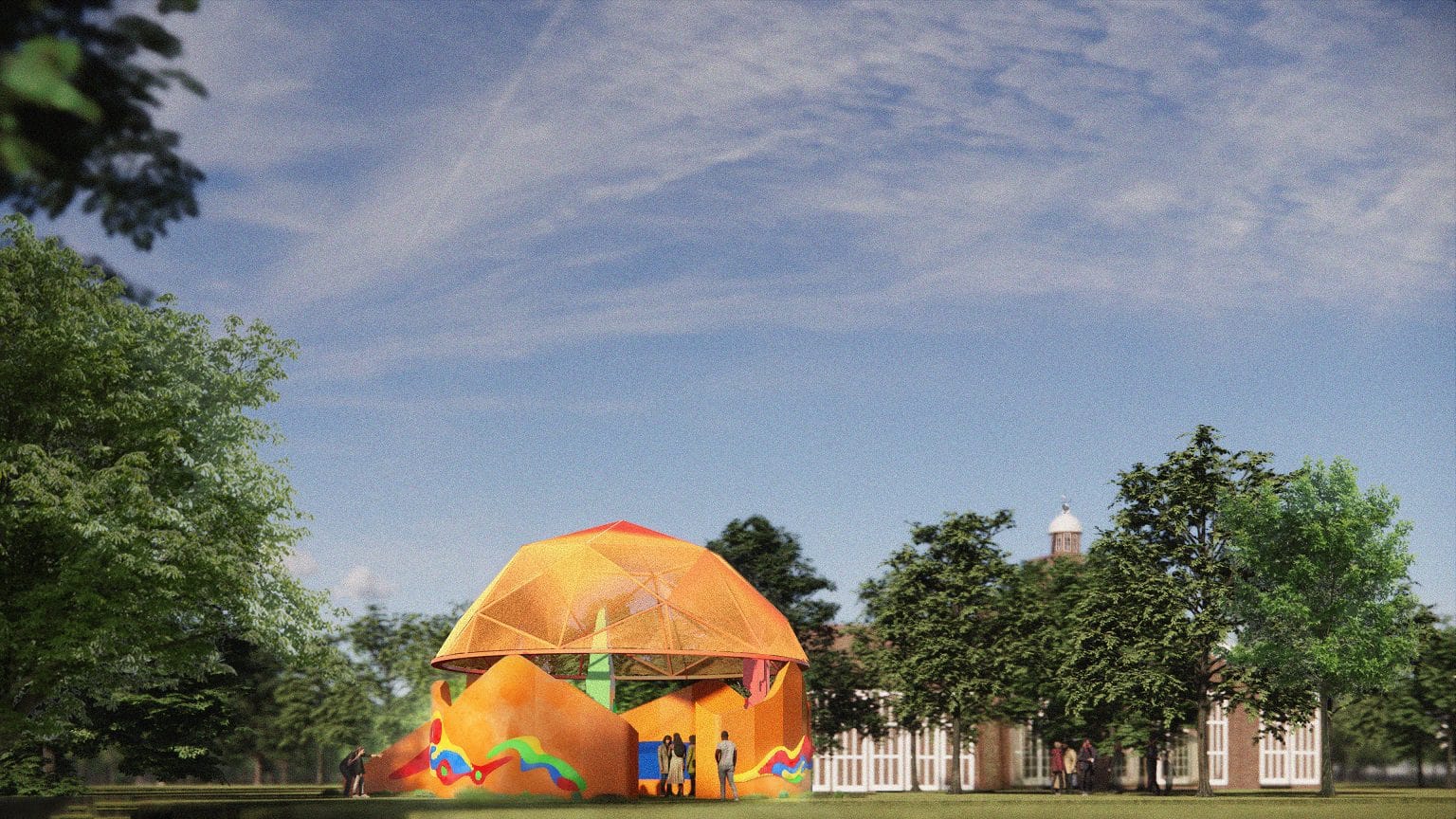
I think we are as direly in need of novel approaches to play as we are so desperately in need of new ways to engage with art. They can be permanent or temporary, they can be sculptural or interactive, they can be huge or tiny, they can even be fun or frustrating. In 2022, the Serpentine worked with Alvaro Barrington to build a basketball court in Bethnal Green, which he brilliantly referred to as a landscape painting. That year will probably be remembered as the high-water mark of social practice, which now appears to be shifting and evolving in response to the demands of our new political moment. This summer, Cook and LEGO together are an inspired choice for an initiation because LEGO is such a fundamentally metabolic, revisitable, plastic way of thinking through material. The Play Pavilion opens 11 June and I can’t wait to visit.
Louise Bourgeois (Fubon Art Museum)
Our first stop in Taipei last week was to Fubon Art Museum’s ongoing Louise Bourgeois exhibition “I have been to hell and back. And let me tell you, it was wonderful.” I first visited when it opened in mid-March, which turned out to be a highly araneidan week as we moved from the mid-sized spider in Taipei to the enormous one installed outside of Bangkok and finally to a diminutive one at a gallery show in Hong Kong. The exhibition in Taipei has traveled from the Mori Art Museum, where it was a slightly larger presentation. Exhibitions at the Mori are invariably installed with an enviable level of slickness: you’re dumped right in, then impelled onward through a combination of narrative and crowd flow, and finally extruded through the gift shop, where the merch is reliably excellent. Everyone I know now has “Hell and Back” either on a throw or on a hoodie. In Taipei the museum, which just opened last year, is exploring how its space can be used with each exhibition. The triumph of this show is the installation of Crouching Spider, the only work that can really make use of the architecture. FAM is essentially a Renzo Piano pavilion, open to the street with dynamic glass windows, and this nesting sculpture can take advantage of that relationship between inside and out to a powerful degree. I imagine we’ll see more of that kind of dramatic use of the space in the future.
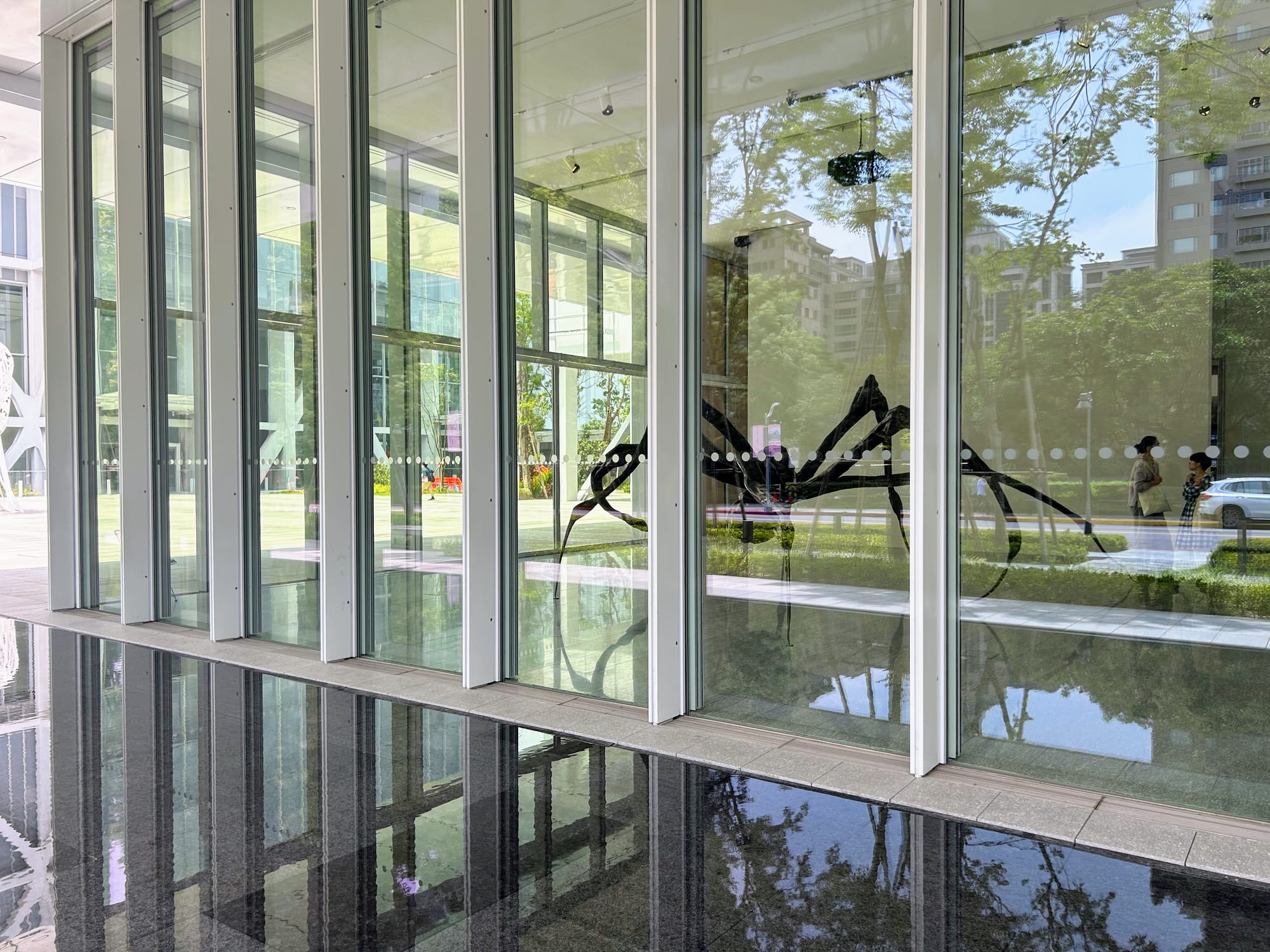
The second spider of that week was the epic Maman installed at Khao Yai Art Forest a few hours outside of Bangkok. (I say second but of course there were multiple other spiders at Fubon as well, including the excellent 1997 version crouching over a cage.) It is truly one of the great experiences of public art wherever you encounter it, whether in Tokyo or outside Seoul (or Arkansas or Ottawa, though I haven’t had the pleasure). Originally commissioned for the Turbine Hall—the first work to occupy that space—it will be returning to the Tate Modern next month to mark its 25th anniversary. Context is everything, and in Khao Yai the spiritual dimension is activated to particular effect, part of a day-long trail through secondary forest and blazing sun that also includes the rewilding stupa fragments of Ubatsat and a mesmerizing fog by Fujiko Nakaya. Here you can put your back to the ground, your hand to the bronze, and squint up at the marble eggs against the sky with just the sounds of wind and insects and a little laughter.
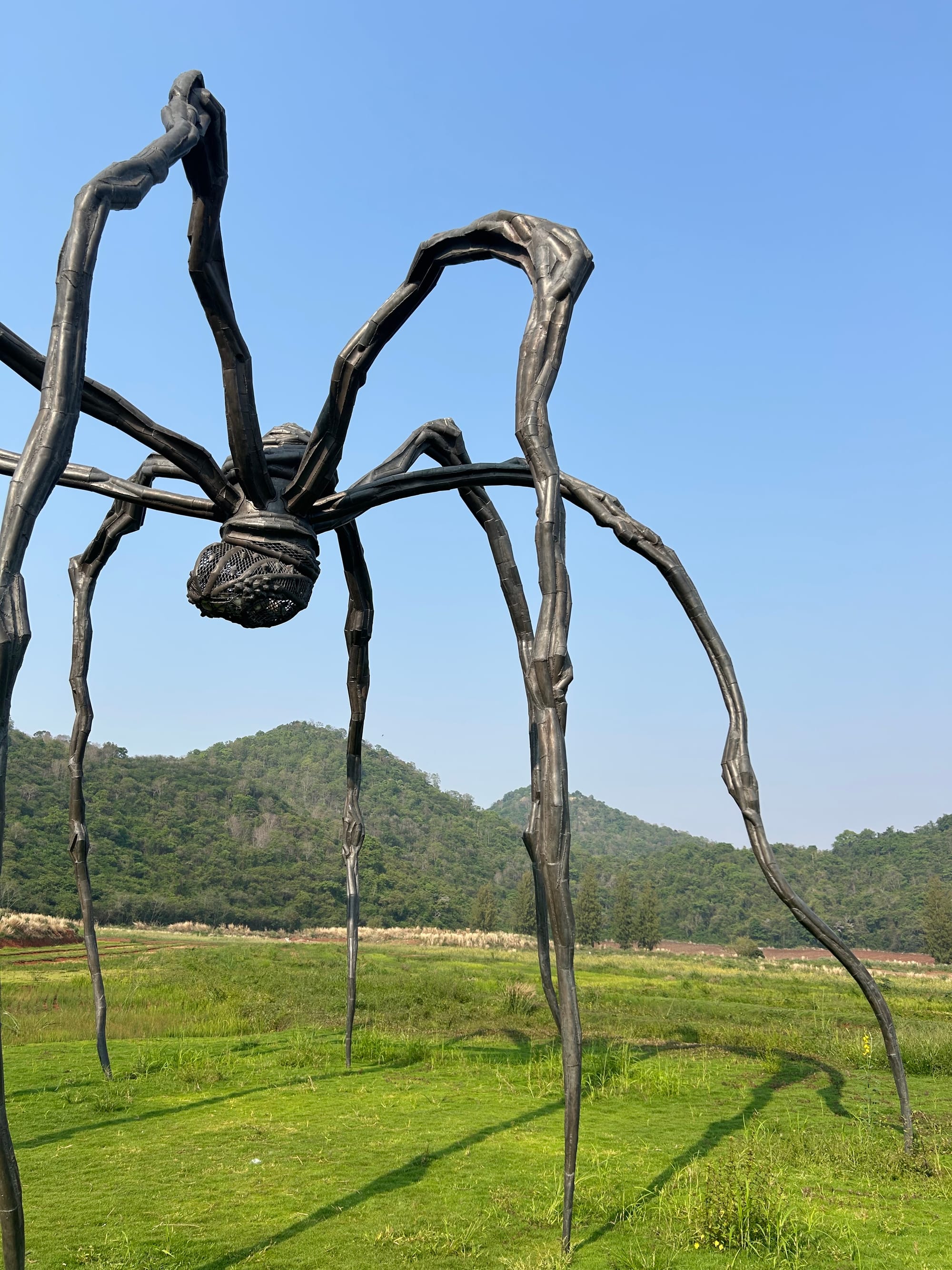
But my favorite spider was probably this delicate little one in a corner of her show “Soft Landscape” at Hauser & Wirth in Hong Kong, which opened as we arrived there from Bangkok. All of the bronze spiders come in different textures and there are distinct preferences among collectors and curators: Maman is rough-hewn, almost industrial in its composition, while Crouching Spider is considerably more naturalistic, tense with twisted muscle. This tiny Spider falls somewhere between the two, with the welding marks of the former but also a bit more of the hand to it, its body with something of a Giacometti to it. What makes me tingle is the one limb that so tenderly cradles the ostrich egg with an effervescence of care and affection.
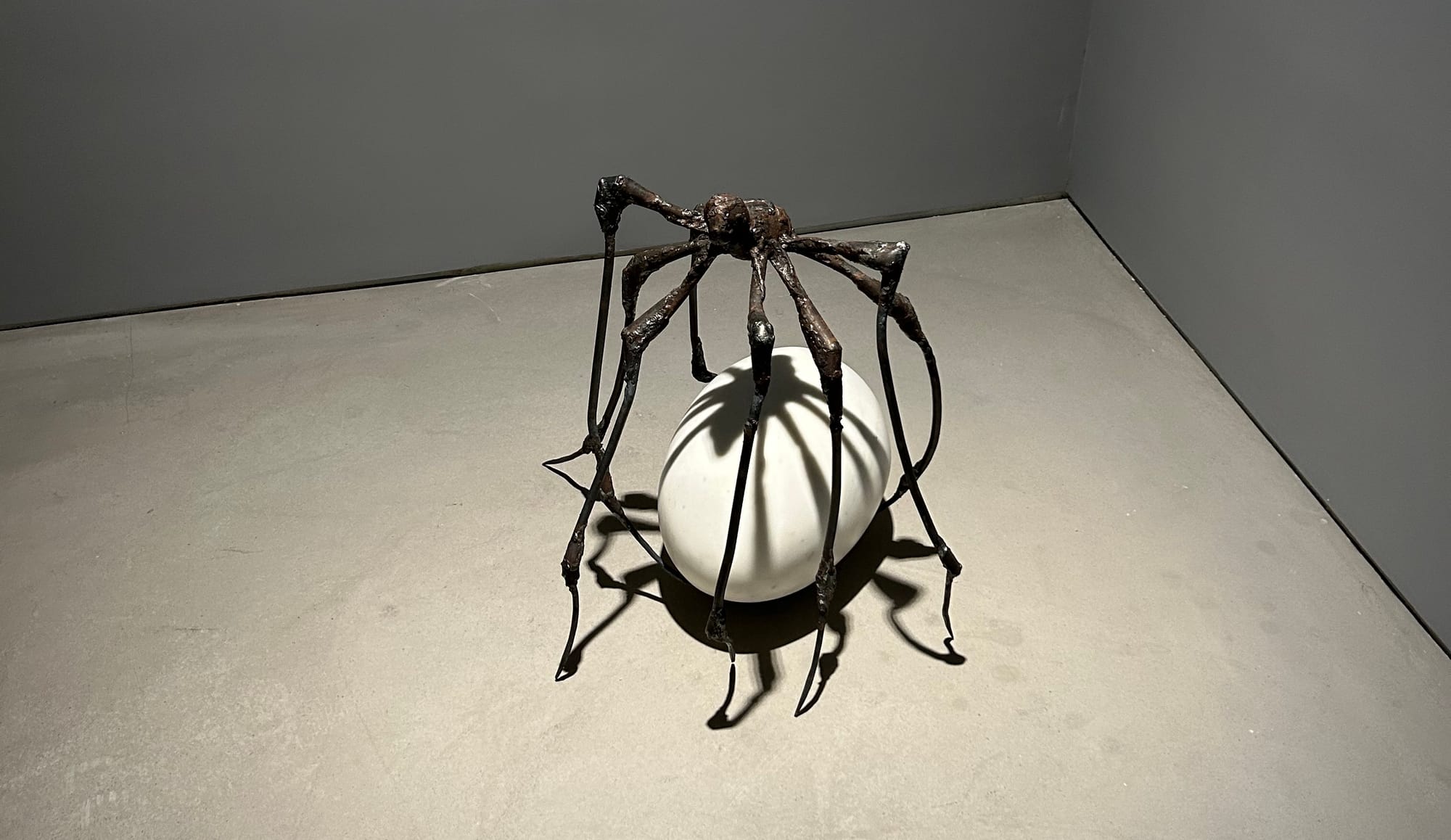
It is well known that Bourgeois ascribes to her mother/spider the qualities of creation, industriousness, and protection. Here we see that this nurturing is not a function of scale.
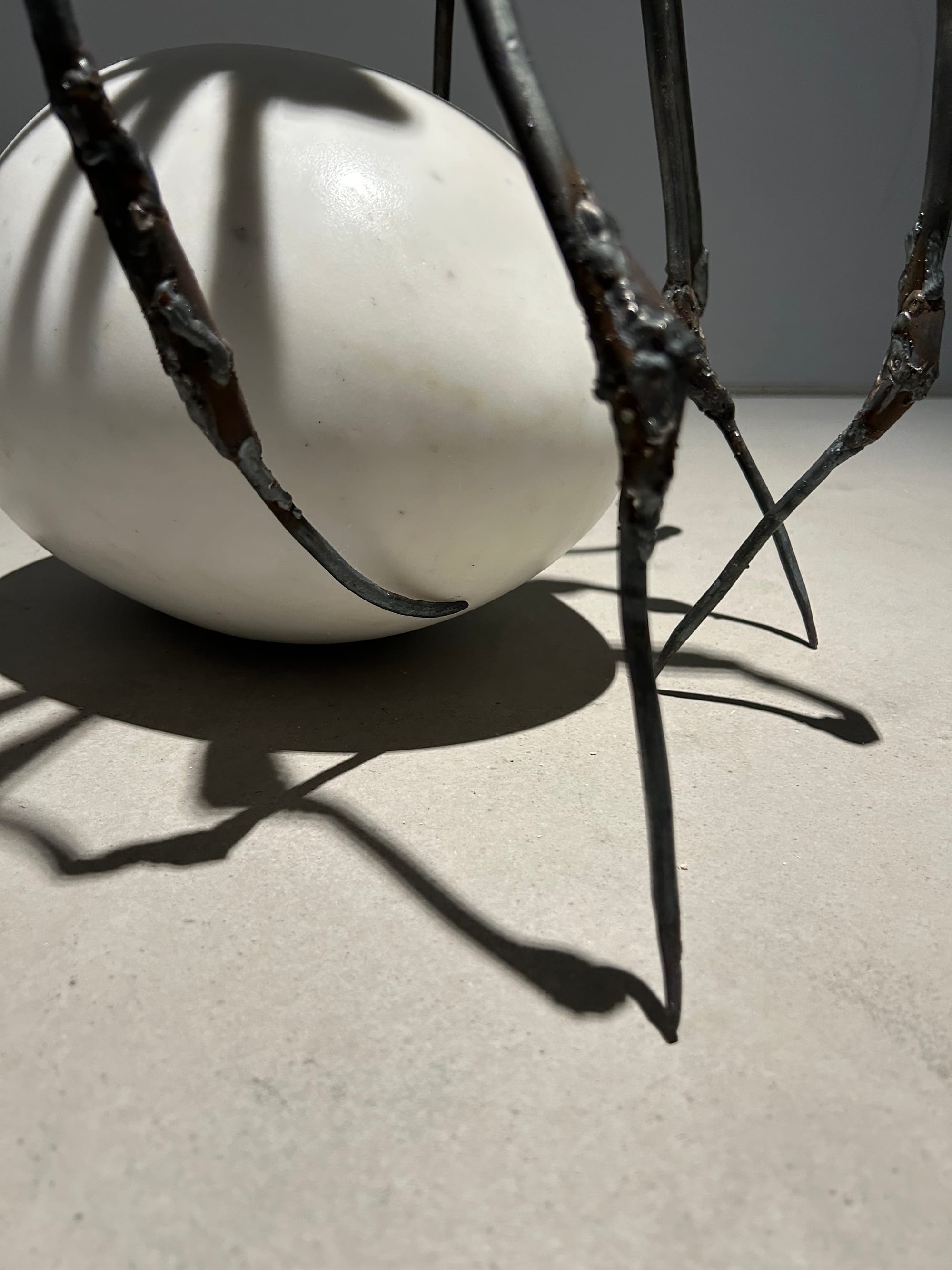
Nostos is a weekly newsletter about making a home at the intersection of art and life. Essays is an occasional column that teases out in greater depth how family life appears in culture.
Earlier this winter I was lucky to catch the retrospective of Suzanne Valadon at the Centre Pompidou on what I imagine will be my last visit to that museum until it reopens in 2030, god willing. It was a rare personal trip to Paris outside of my annual fall pilgrimage for the art fairs. This time it was romance that brought me there, a fact that everyone I told almost uniformly agreed was the best reason to visit their city. So I was in a certain state of mind as I stored my dripping umbrella and made my way up through the escalator tubes to the special exhibition galleries, making my way between the spaces of the in-between, endings and beginnings, hellos and goodbyes and all of that. I had never heard of Suzanne Valadon and had no idea what to expect, other than it came highly recommended, but there is a certain freshness to seeing something in the right company, in holding one’s eyes open out of curiosity and hope, and I was rewarded immediately. From the opening salvo of the exhibition, Suzanne’s paintings assert themselves with the immediacy of gestural brushwork and an imposing weight of meaning and consequence.
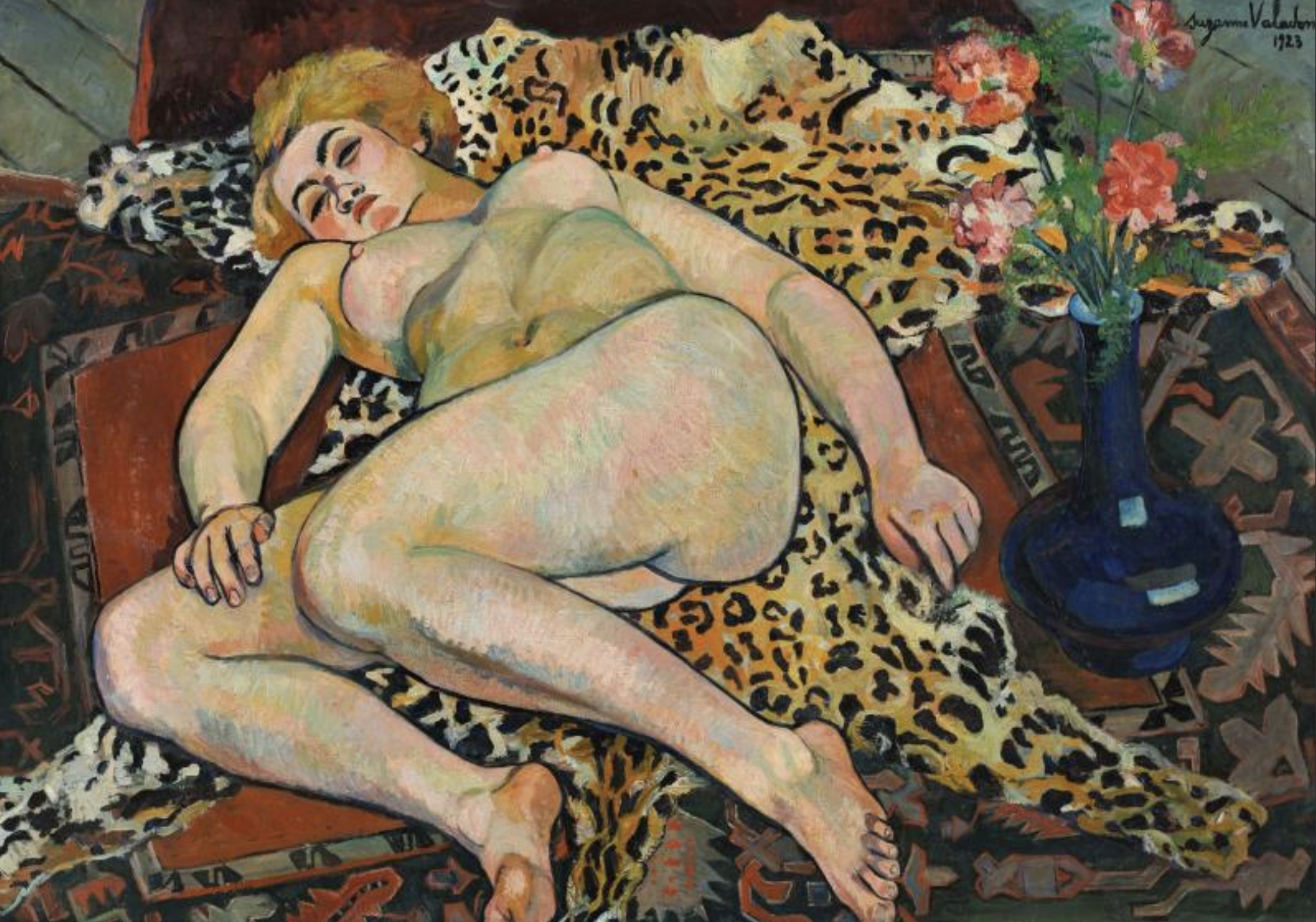
Although I am no expert, assuming that some readers will be as unfamiliar with her work as I was, I will share a brief biographical sketch: Suzanne was born Marie-Clémentine Valadon in 1865 to a single washerwoman in Montmartre, and came into contact with art when she began modeling (among other odd jobs) at the age of 15 for Henri de Toulouse-Lautrec, who gave her her nickname—after the biblical Susanna. She also drew, and received encouragement from Toulouse-Lautrec and Degas. Becoming a single mother herself at the age of 18, she continued living with her mother, and developed a practice of portraiture based on her mother and son, as well as lovers and friends from a wider circle as she rose in social status through the reception of her work.
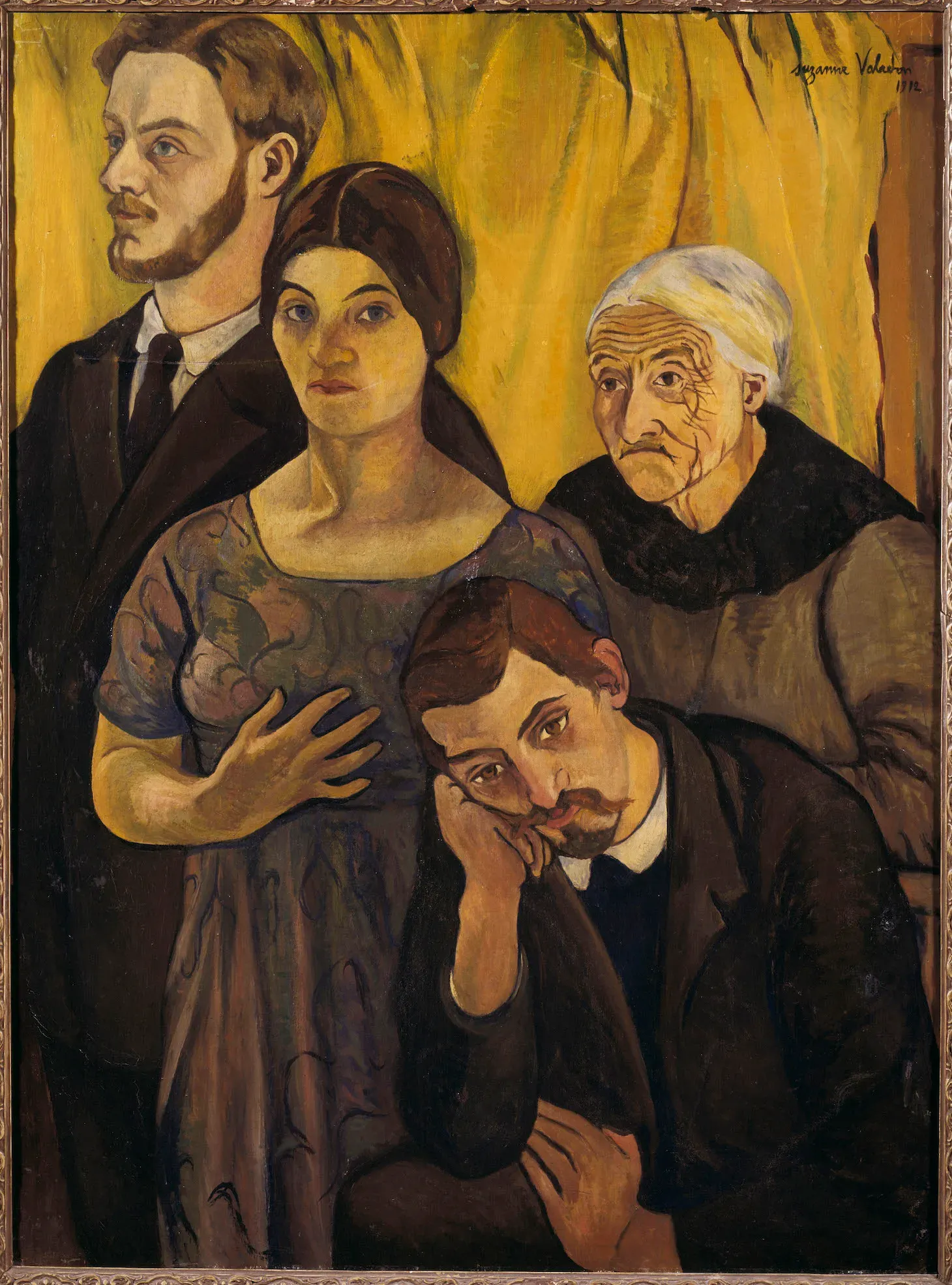
It should be clear from this description alone how Suzanne’s work fits into the story I have been telling about how the life of the family fits into and alongside the life of the artist. With Adam et Eve (1909) she became, some say, the first woman to paint a full-frontal male nude; her new husband guides her hand towards the forbidden fruit. Portraits de famille (1912) pictures her surrounded by her mother (whose face is deeply scarred with wrinkles here and nearly everywhere she appears), her son (dreamy and erect), and her second husband (resigned; at peace). One of my favorite pairings in the exhibition captures the arc of childhood: Marie Coca et sa fille Gilberte (1913) finds Suzanne’s grandniece with a doll on her lap, leaning against her mother’s legs. Later, in La Poupée Délaissée (1921), the girl is grown, turning away from her mother and absorbed in her own reflection in a handheld mirror. The titular doll—the same one from eight years earlier—rests on the floor. Suzanne had a special love for mirrors, both handheld and wall-mounted, and for boudoir scenes, and in particular for the twisting and stepping poses of getting into and out of the bath. (See La Petite Fille au miroir, 1909.) She is, I believe, the patron saint of the rear three-quarter-angle nude.
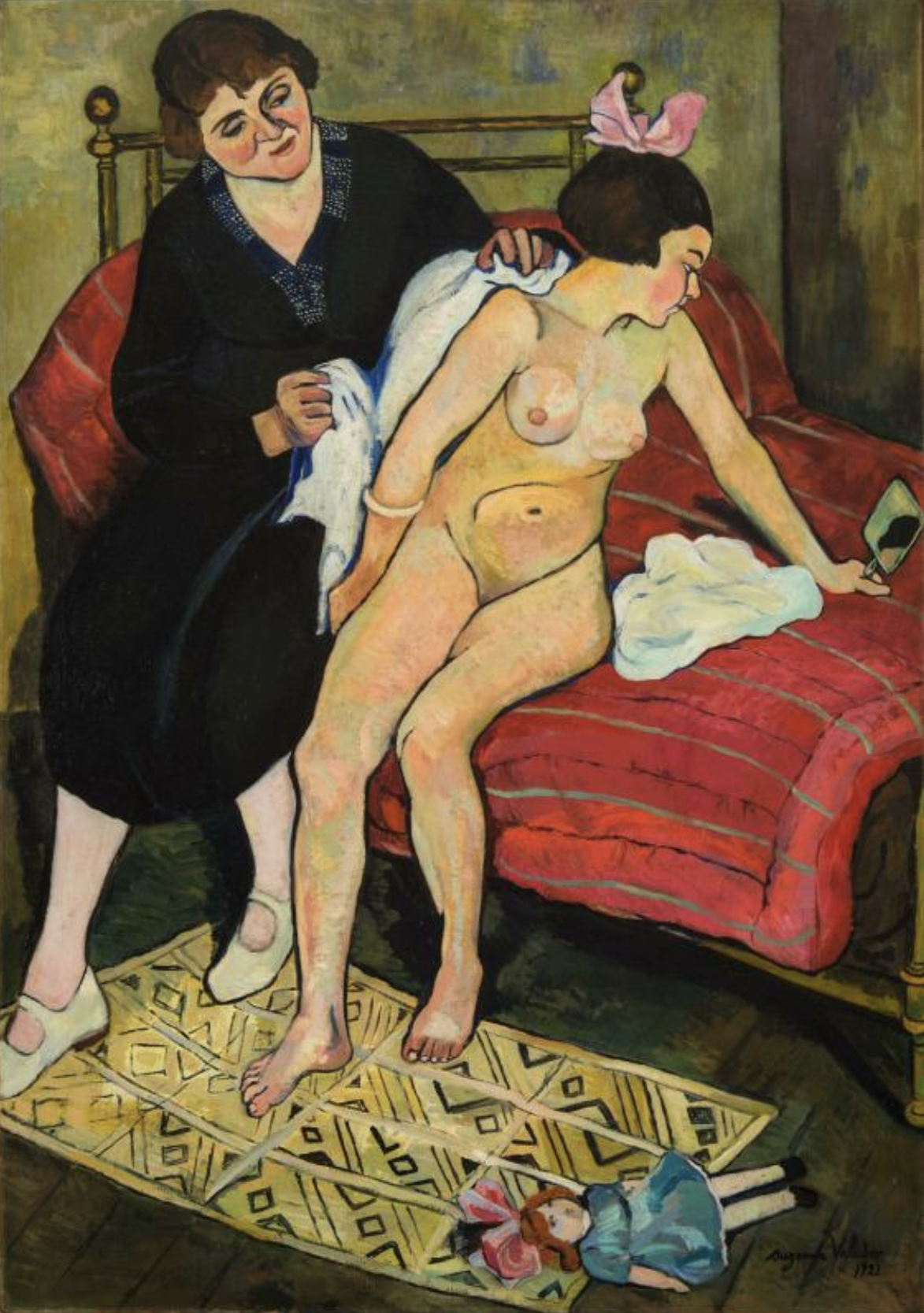
Suzanne made what I consider her best paintings in her fifties and sixties, in the two decades prior to her death in 1938. The Pompidou exhibition opens with La Chambre bleue (1923), one of several pictures that are so stupidly brilliant that they could pull the wall straight down into the floor. A heavyset woman in a pink camisole and striped green pajama pants rests on one elbow, books at hand, an unlit cigarette between her lips. The bedspread is Matisse and the wall behind is Joan Mitchell. From the same year, Catherine nue allongée sur une peau de panthère (1923) has a reclining nude on a leopard skin over a rug, pink poppies in a blue glass vase perched perilously close to languorously draped fingers. The rainbow skin of this buttock slam in the center of the frame—it contains the universe.
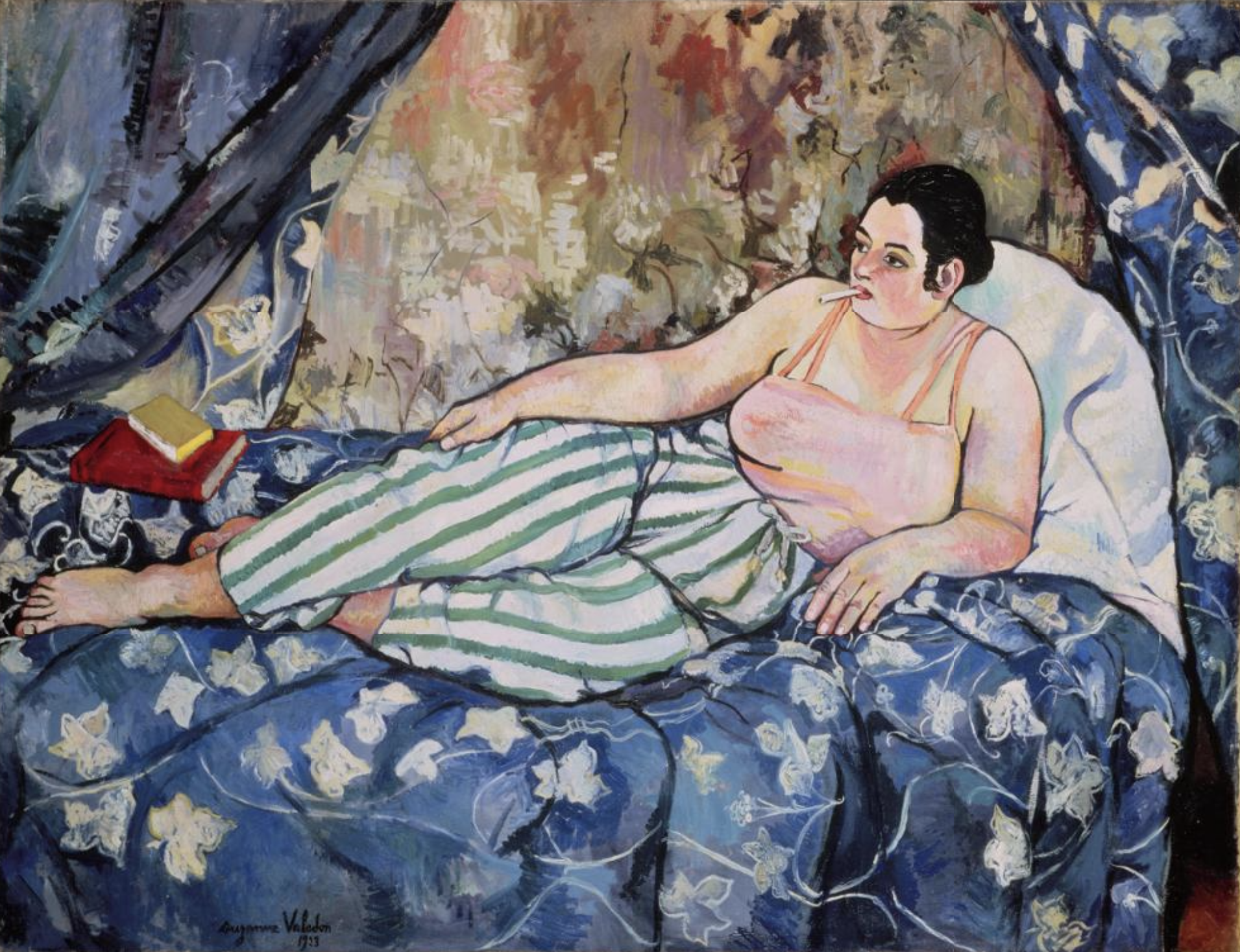
In a series of self-portraits made when she was 62 or 63, Suzanne depicts herself in what I can only describe as the harsh light of loving self-acceptance. She has none of the luscious skin finish of her nudes, and none of the cinematic airs of some of her other portraits. She is not young, but she is not old—at least she has far fewer wrinkles than she gave to her mother earlier in her career. My favorite is Autoportrait aux sens nus (1931). At this point she has been painting herself in the nude for decades, and yet it can’t have been common for a woman of her age to look back at the viewer so defiantly dignified, so much a part of herself. In the way she handles the skin of her left shoulder, partially in the shadow of her face, I see something of Celia Paul’s palette. And, of course, this brings us to Alice Neel.
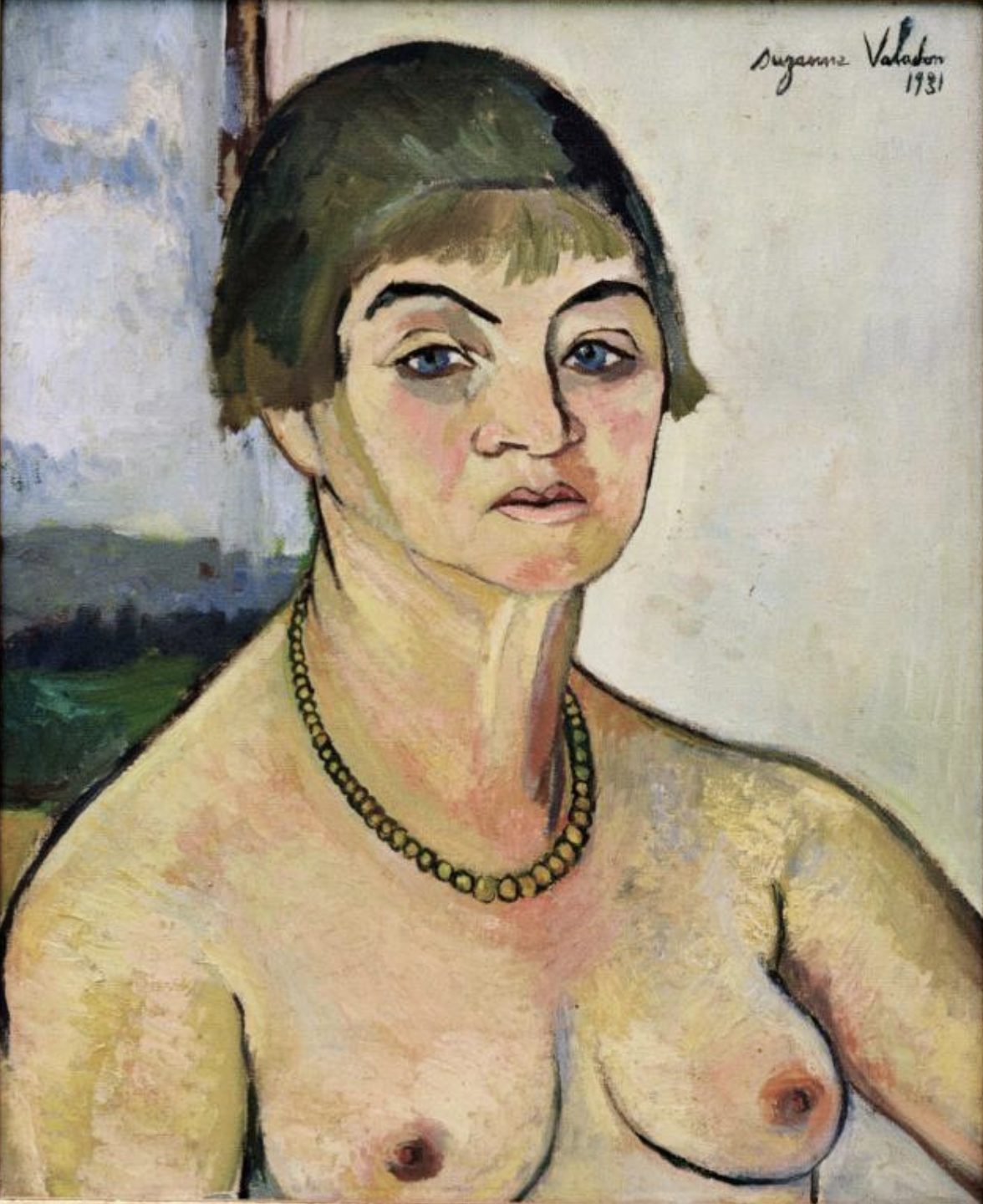
I am hardly the first to notice the shared sensibilities between Suzanne Valadon and Alice Neel. First and foremost, the thickness of line with which they both tend to outline the bodies of their sitters; it is visually striking and makes for a unique conversation across time between these two women. And of course, the empathy for affect and feeling in the body of the sitter, particularly in the seated domestic interior portraits that form such a significant portion of both of their work. If there is one significant point of departure, however, it is in Suzanne’s sumptuous attention to the textures and patterns of her interiors. In Alice’s pictures, everything beyond the person—sometimes everything beyond the face, even everything beyond the eyes—fades into irrelevance. For Suzanne, a person must be situated: placed within the context of their costume, of the furniture, of the room. We see the same couch, the same throw in many pieces, and we see her own environments shifting and evolving over time. Where Alice pushes back at the encroaching domestic sphere (a topic I will turn to in the next part of this essay), Suzanne indulges it in all its messiness and improprieties, painting a universe perfectly parallel to the escaping tulips of Dora Carrington’s still life.
Nostos is a weekly newsletter about making a home at the intersection of art and life. Shorts is a regular column with links and commentary on family culture.
Hervé Guibert (Magic Hour Press)
My car is in the shop so I have an extra hour or so of reading time on the bus. This morning I read, twice, through Hervé Guibert’s photo novel Suzanne and Louise. Guibert has become one of the most important touchpoints for autofiction, and this book I find fascinating for its beautifully skewed take on how an artist might turn family life—his own and, simultaneously, someone else’s—into the material of his work. It’s a weird, weird little story, consisting of 44 black-and-white photographs of his two elderly great-aunts in their Paris home interspersed with snippets of text on their day-to-day lives, how they came to lives such lives, and his process of getting to know them and, indeed, work with them, as they become artistic collaborators.

What emerges, unexpectedly, is a lived theory of photography, not so different from how Roland Barthes’s theory of photography in Camera Lucida emerges from a photograph of his own recently passed mother as a young girl—a photograph Barthes describes but never shares. In his text, Guibert describes his aunts’ approach to their images “as if photography were a sacrificial practice.” In the prologue: “They perform, for him, a dramatization of their relationship.” The young artist participates in an improvisation that becomes a real part of his life. The art is the life, and the life is the art. There’s no distance between them. Guibert published the book at the age of 25; he died of AIDS at 36, which is also my age as I write this.
Annie Ernaux and Marc Marie (Isabella Bortolozzi)
Annie Ernaux, too, has become one of the core reference points of our current strain of autofiction or memoir, though on the opposite end of the spectrum. She lives within memoir, speaking to the truth of experience conveyed through literature. This past weekend marked the close of an exhibition of photographs by Ernaux and Marc Marie at Isabella Bortolozzi in Berlin. Titled “BEDROOM, CHRISTMAS MORNING” after a photograph in the show, it is a simple project of 14 images: over the course of their year-long affair, the lovers photographed the mise-en-scene of the morning after, the state of the room after their liaisons—mostly clothes on the floor in varying states of disarray.
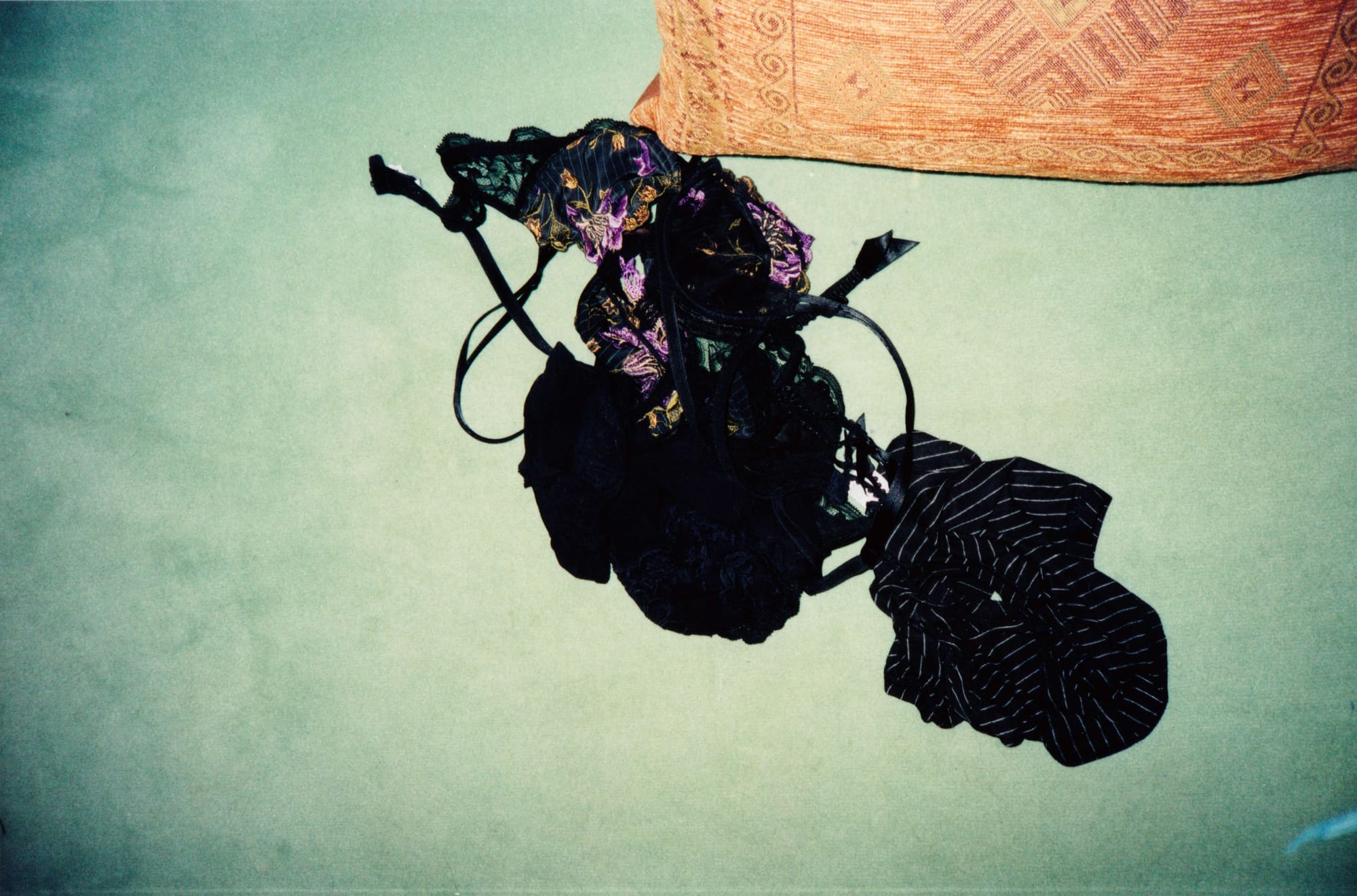
They, too, turned their relationship into an art project, writing short texts to accompany each image that they only shared with each other after the close of the year. A book bringing together their words and photographs has just been published by Fitzcarraldo, though I have yet to read it. The affair coincided with Ernaux going through chemotherapy, a context that shifts ever so slightly the suggestions of touch, of intimacy, that are inherent to these pictures. A superb essay by Jonathan Alexander in the Los Angeles Review of Books looks at both of these recent books in terms of the “theatricality of the quotidian” and the structures for living that they propose. I think that structures like these are some of the most life-giving things that we can learn from artists. Life as a project.
Ruth Asawa (New York Times)
By way of previewing Ruth Asawa’s upcoming retrospective at the San Francisco Museum of Modern Art, Hilarie M. Sheets visits the artist’s home in the city. I have to present this without comment:
A lot of times she worked right here,” [Asawa’s youngest child] Paul said, pointing to a discreet hook at the center of a double-wide door frame between the living room and kitchen, where Asawa would hang her looped-wire works in process. “She could sit, or she might have to lie down,” Paul said, as the scale of her curvaceous forms grew, adding that it was a convenient spot to monitor what was cooking for dinner. At the long butcher block kitchen table built by [her husband] Albert, Asawa led group sessions sculpting figures from homemade baker’s clay (a mixture of flour, salt and water), or decorating eggs or making origami by day and family meals by night. “The most important thing to this family was that we sat down to dinner together every single night,” Asawa once told an interviewer. “There were eight of us at the table, plus friends."
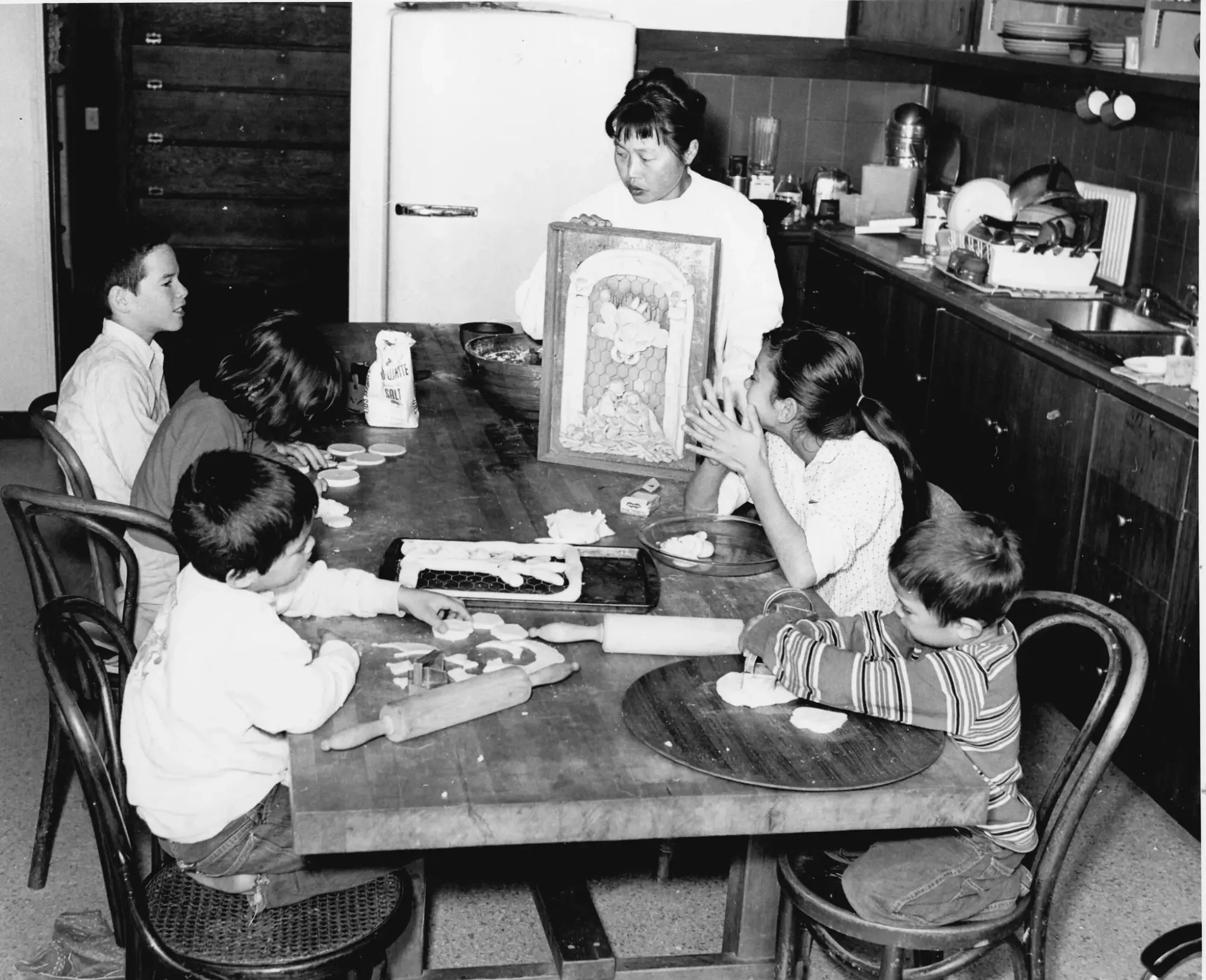
There is a new book out by Jordan Troeller that I am dying to read called Ruth Asawa and the Artist-Mother at Midcentury that looks at motherhood “as a means to reimagine the terms of artmaking.”
Rose Wylie (Great Women Artists)
Nonagenarian painter Rose Wylie opened an exhibition at David Zwirner in London this week, and promoted it with a series of wonderful studio visits, including an excellent episode of Katy Hessel’s "Great Women Artists" podcast. Born in 1934, Wylie studied art, stepped away from her practice to raise her children, and then returned to the work in her forties newly invigorated and feeling like she had a lot more to bring to it.
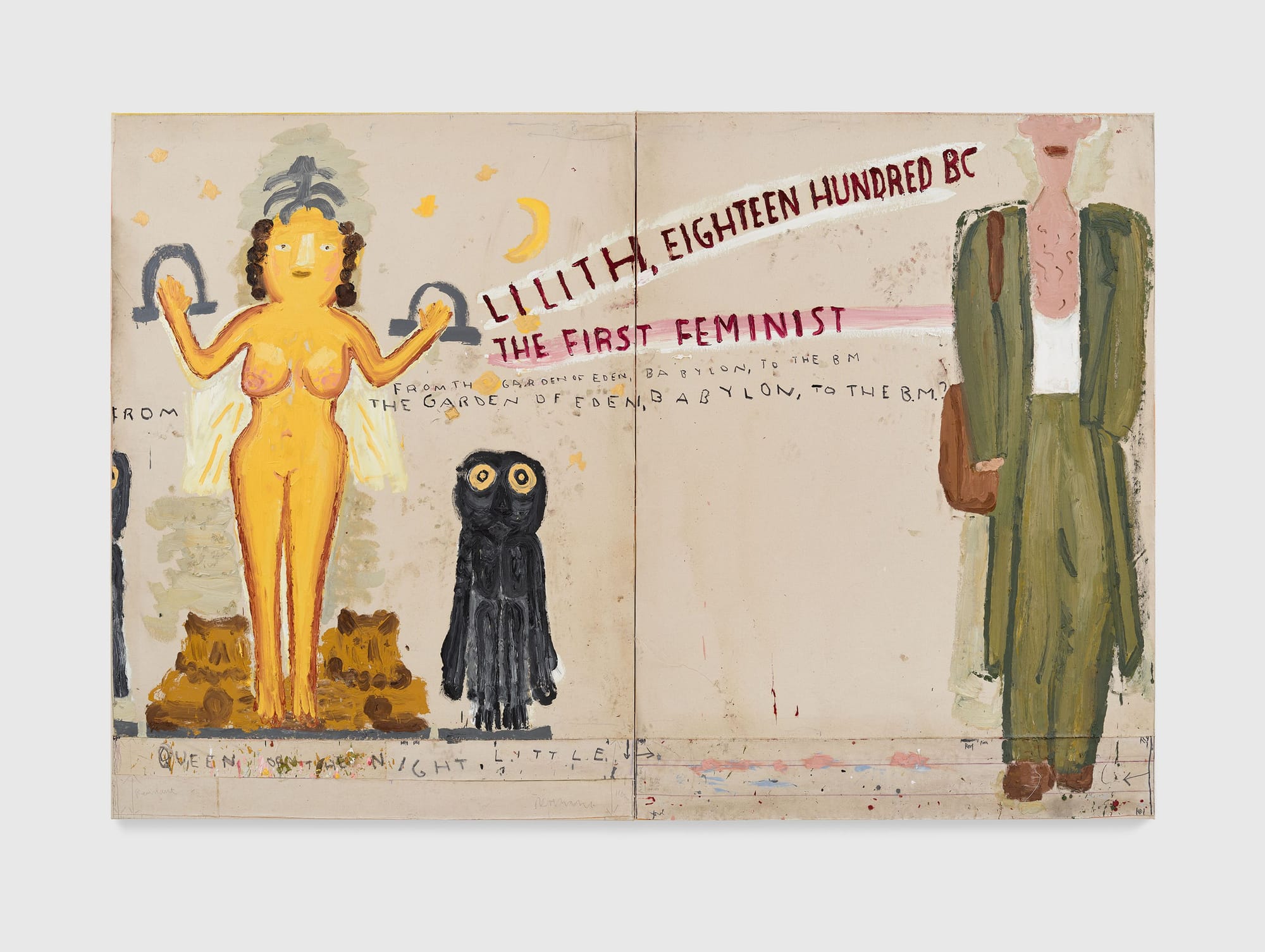
I love to hear the stories of how different artists position the work of the home and the work of the studio in relation to each other: for every famously uninvolved mother like Alice Neel or Celia Paul there is a Ruth Asawa building sculpture in the kitchen or a Rose Wylie putting children first. In the podcast Wylie says that she believes that being a mother was an important part of life, and that being a wife was an important part of life. She recalls how her tutors in art school looked down on women who they expected to marry and have children and walk away from art. They were right, she concedes—but not exclusively right. She came back. And, for her, the walking away was not a defeat but part and parcel of the whole thing.
Ed Atkins (Tate Britain)
I can’t wait to see Ed Atkins’s retrospective at the Tate Britain this summer, which by all accounts is an expansive staging of his career. For me Ed is the ultimate poet of the digital self, reflecting back at us how we collapse and inflate ourselves in spaces we can hardly understand with our physical bodies of flesh and blood. Family has become an important part of his work, particularly in the last few years after he became a father—his artist books’ of the post-it note drawings for his daughter’s lunchbox first brought him onto my Nostos radar. But since then, I’ve come to think of this lens as less specifically about artist parenting and more generally about how artists situate their practices within their lives, and Ed’s work on his own parents fill out this picture. Some of his most significant films frame these relationships one by one: The Worm (2021) was a conversation between his own avatar and his mother, focusing on a family history of depression in the depths of the Covid pandemic.
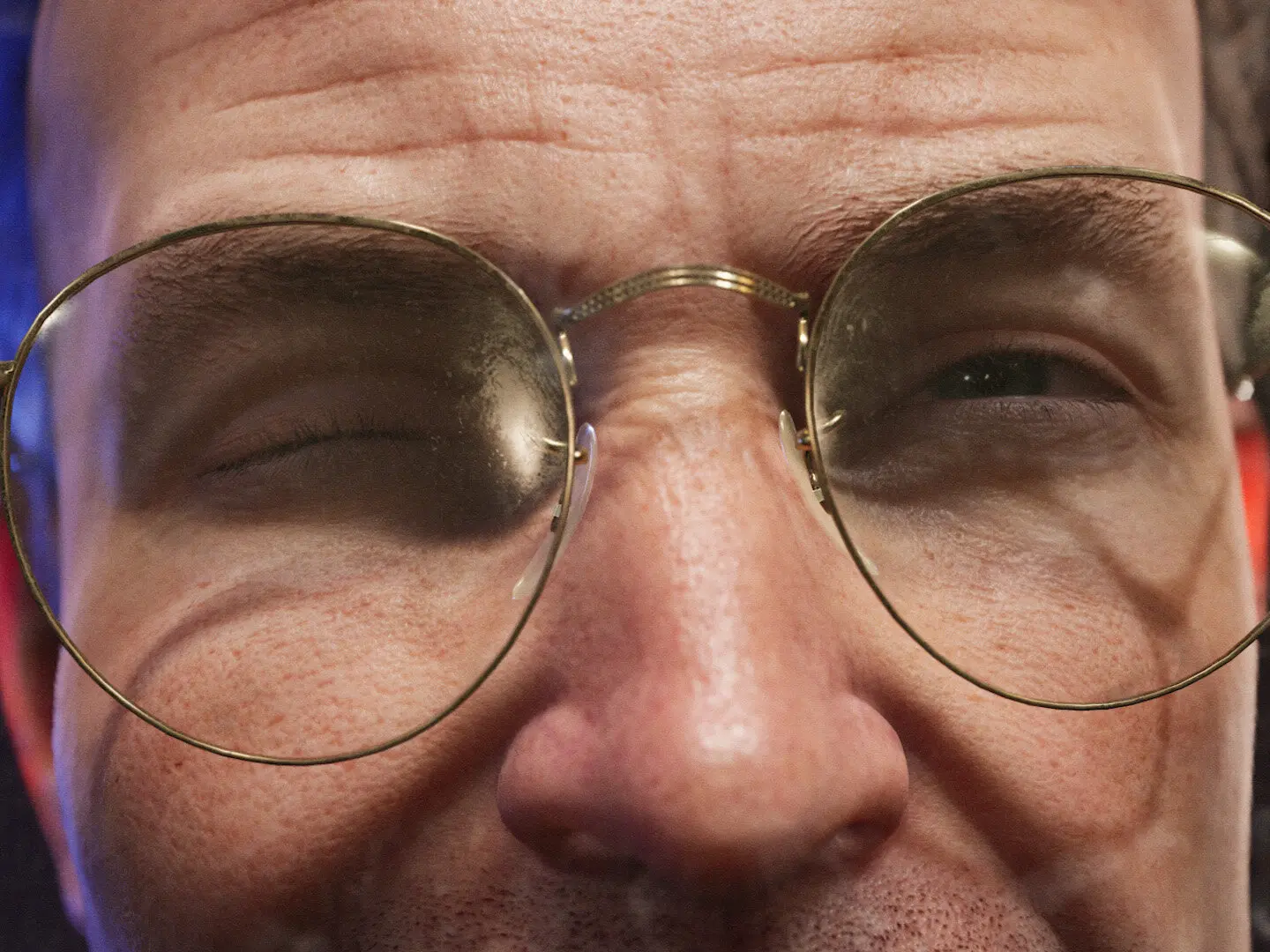
In the new film Nurses Come and Go, but None for Me (2024), an actor reads journal entries that Ed’s father wrote as he was dying of cancer while the artist was in school. In his review, Adrian Searle describes the triangulation of parent, artist, and child:
After the reading is finished Peter and Claire play a game devised by Ed Atkins’ young daughter Hollis Pinky. Peter has now adopted a further persona, and lies on the floor, and Claire, taking the role Ed Atkins used to play in this once-private game, first pretends to be an ambulance, then some sort of doctor, who attempts miracle, fantasy cures for imaginary ills, games of coping and resuscitation, of childhood fears being allayed through play.
Writing on these attempts to “catch the irretrievable moments as they pass,” Laura Cumming says that Ed’s child resists “all this projected significance.” So it goes.
The Guardian loves Ed: Adrian Searle gives him five stars, Laura Cumming only four, and Tim Jonze shares an interview.
Nostos is a weekly newsletter about making a home at the intersection of art and life. Essays is an occasional column that teases out in greater depth how family life appears in culture.
Portraiture for me has become a practice of autofiction. When I started my career, I was obsessed with technology and bored by painting. I was undereducated and under-informed, and have only learned a little bit since then. A lot of my writing and thinking in the first decade of my career was on what we called post-internet art, which Karen Archey and I defined as contemporary art “consciously created in a milieu that assumes the centrality of the network.” A key point of reference for us was David Joselit’s idea of painting beside itself; I remember Karen telling me about a dream in which she titled an exhibition “Everything Beside Itself.” Up to a certain moment, the only painting that made sense to me was conceptual in nature, playing with the codes of digital culture to make painting about its own production. Following David: Jutta Koether, Wade Guyton, Seth Price. Serious and impersonal painting.
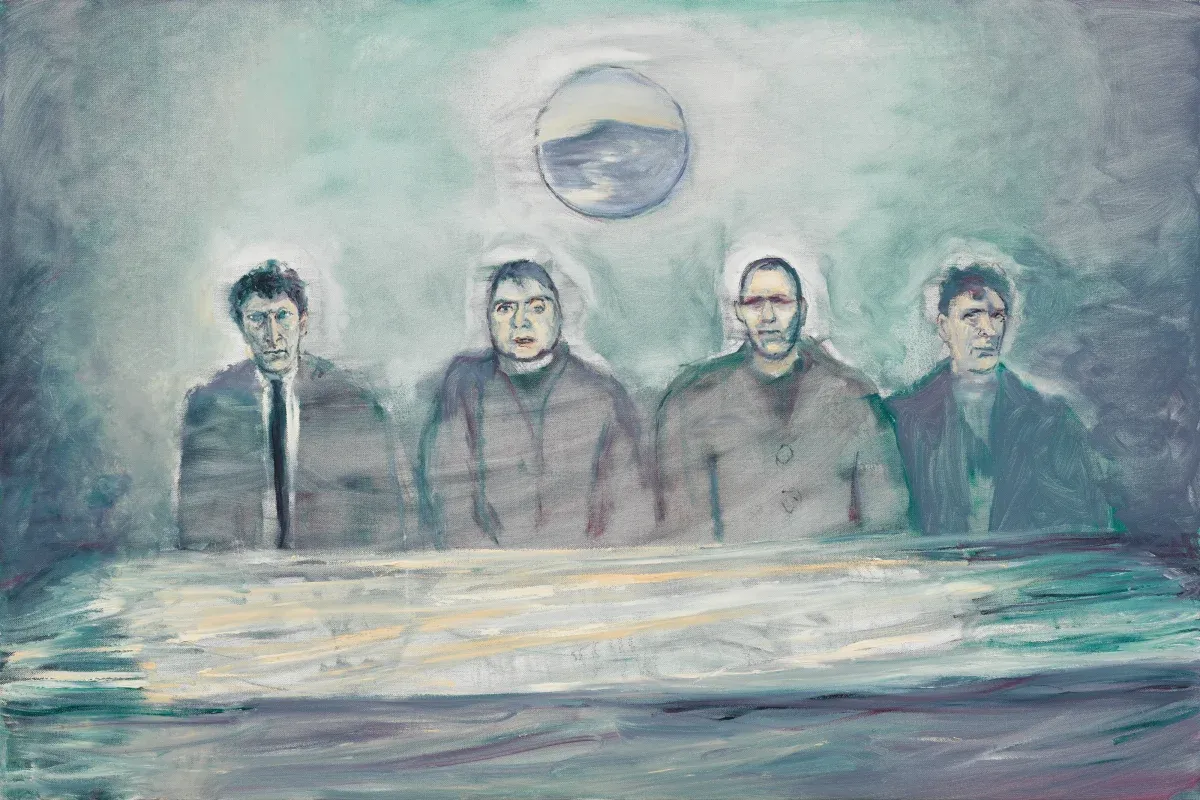
Through approaches to portraiture like Celia Paul’s, I have slowly come to understand how every painting stands beside itself, how the social diagram of the production of art is actually visualized in many kinds of painting, if not most, and acknowledging this reality is, in fact, one of the primary directives of looking at and talking about art. In her current exhibition in London, Celia recomposes a famously staged photograph of Lucien Freud, Frank Auerbach, Francis Bacon, and Michael Andrews out to lunch in Soho in 1963. This is not a biographical anecdote. This is painting fully beside itself. There is zero distance between Celia’s Colony of Ghosts and Jana Euler’s “GWF (Great White Fear)” paintings.
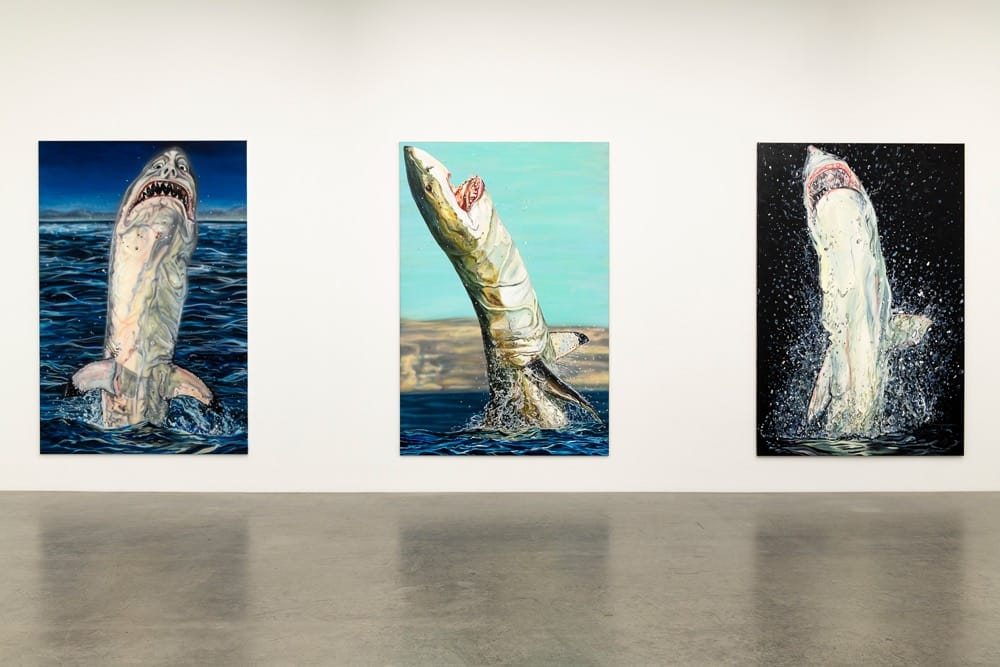
At the London Review Bookstore a few years back I picked up a copy of This Dark Country, a striking book by the curator and scholar Rebecca Birrell that has become enormously important to me. Subtitled Women Artists, Still Life and Intimacy in the Early Twentieth Century, it is something of a group biography of Bloomsbury, and a project of criticism that invigorates still life as a visual key to the interpretation of the domestic lives of the artists. One might call it still life beside itself, or the domestic interior for the age of metadata. The basic observation is unassailable: these artists were living and working in unusual and radical domestic configurations, and so the visual environments pictured in their work bridge the practice itself with the life around it. Another way of describing the modernist mode.
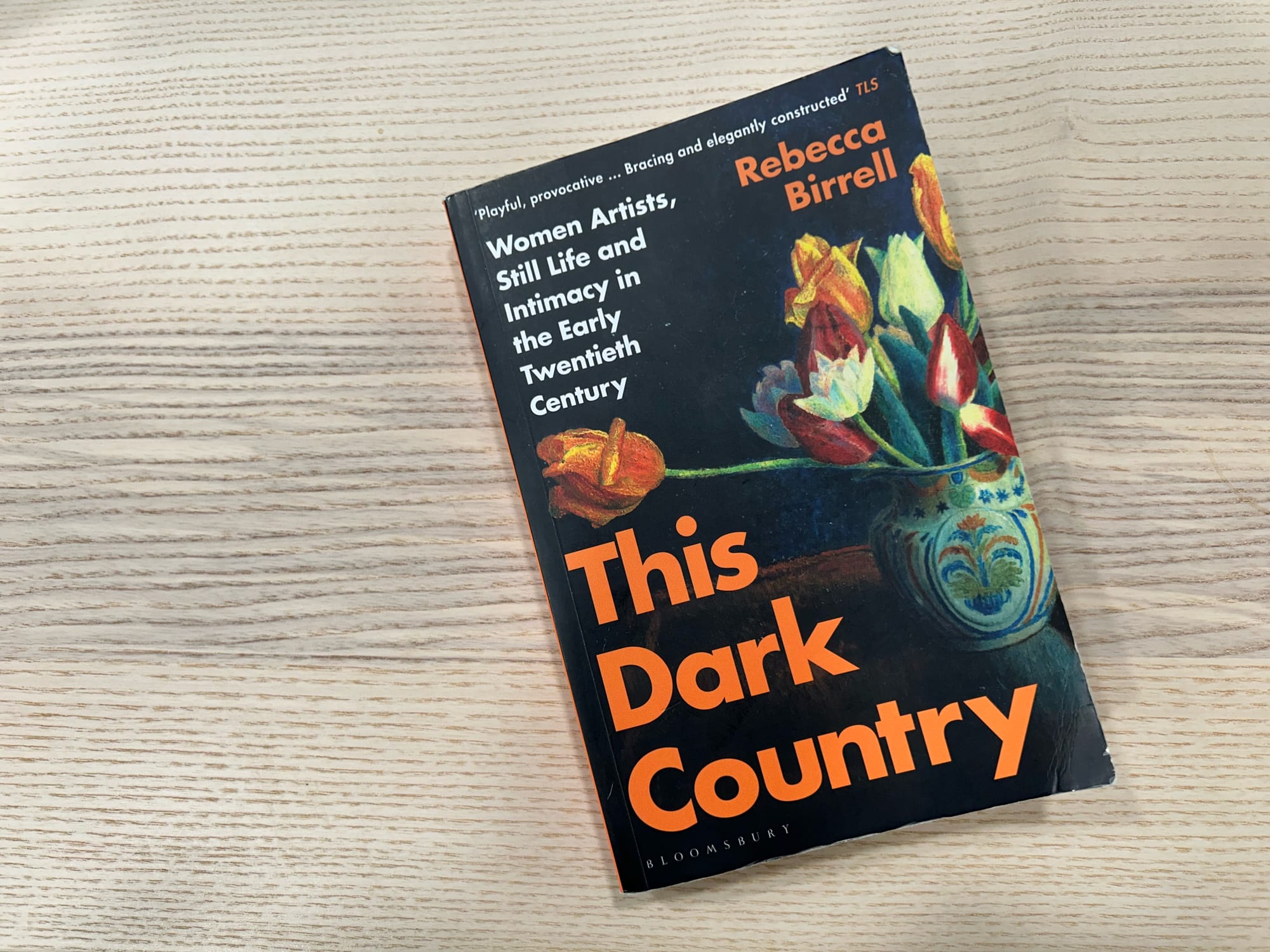
In This Dark Country, Rebecca’s observations are always striking. Often they are elucidating; sometimes they seem to be reaching, and yet when they are reaching they are also at their most creative. She calls her form of close reading “overreading,” after Eve Kosofsky Sedgwick, and says she is “more interested in possibility than proof.” This, I think, is where the creative possibilities of criticism come into play, where criticism can be more than biography, and where the reading of a critic might open up new windows into the work, and for the work into the world. And this, after all, is why we write criticism to begin with.
On the cover is a detail from the Dora Carrington painting Tulips in a Staffordshire Jug (1921), in which Rebecca identifies two tulips “attempting to distance themselves from the rest of the bouquet,” leaving behind “intimations of disappointment, need and discord.” She goes on to connect the composition to her lover Ralph Partridge and the triangulation of their relationship within Bloomsbury. As a reader, you have to learn a lot about the biography before you can begin to see anything in the paintings other than genre and technique. In my generation we are sadly inured to the spiritual life of a still life with flowers.
Studying theory and criticism in college, we learned to be suspicious of the biographical fallacy, of the idea that the narrative of an artist’s life might help us understand his or her work in any meaningful way. We should start from the work itself, we learned, and from its reception in the world, and never take the original artifact as illustrative of an external reality. For the past 25 years, literature has been so dominated by autofiction that it has become as natural as breathing. This is not the case in contemporary art. Despite diversions into things like new sincerity and identity art, art has largely tried to preserve a further layer of mediation, even distance—to cling to the position of the critic rather than the artist.
Anna Kornbluh would disagree: in her book Immediacy she argues that the immersive installation as a medium is cut from the same cloth as social media and memoir. I counter that immersive experiences are far enough from the central thrust of what artists are actually doing to undercut this line of thinking. I also wonder if the act of interpretation that Kornbluh wants to see happening, the work of critical engagement, might actually be taking place immanent to the surely self-conscious authorship of much of this culture supposedly opposed to mediation.
Frances Lindemann, writing in The Drift, takes inventory of autocriticism in the literary field: Emily Van Duyne on Sylvia Plath, Rebecca Mead on George Eliot, Jenn Shapland on Carson McCullers, Joanna Biggs on nine women writers. She describes the problem:
Three distinct but related types of identification are at play in this genre, which we might call auto-criticism: the author’s personal identification with a character, her identification with the writer at hand, and her identification of that writer’s life with her work. (This last type is also known as biographical criticism.)
Rebecca Birrell’s biography of Bloomsbury does not reach into memoir, other than in brief asides that mention her research in the first person, but I almost wonder if that might further enrich it. Rather than trying to get rid of mediation, this winking inclusion of the author for me can celebrate the relational nature of the twinned acts of writing and reading. Frances concludes her argument:
Auto-criticism, and its identificatory principle in particular, is most fundamentally flawed in its false understanding of the directionality of reading.
When we willfully misread art or literature, we accept that we are seeing our reflection in the glass along with whatever we are looking at. We recognize that we cannot possibly imagine ourselves in the exact circumstances of the artist—and that we would not want to even if we could, because the whole point of art is to somehow speak across time, across subjectivities, from your universe into mine. Reading is a multi-dimensional practice. We create new dimensions with every reading. When we peer through a frame and into another plane of being we see an act of imagination tied to a real person in a real place and time, and we—real too in our own place and time—must commit another act of imagination. And this makes it no less real. It resonates back and forth, sometimes forever.
What I have learned from Rebecca Birrell is that there are interesting things to learn out there, and archival research plus a trained eye can unearth stories that enrich our readings of art. This is a creative act, and the stories that resonate with us have as much to do with us as they do with the artists.
My mother is visiting Taipei this week and while we were browsing moom bookshop I picked up a copy of The Bloomsbury Cookbook. She is here to spend a couple days with me after a week looking after my daughter while I was away on business at the art fair in Hong Kong. Paging through recipes from Charleston as we recover from a meal of oden and Czech wine, the importance of domesticity, of cooking and eating together, of a good interior, of a communal energy could not be more obvious. In the case of Bloomsbury, the radical impulse comes right up against the domestic appetite, and they are seen to live not in opposition but in harmony, bound up together. I am learning to see in a still life with tulips the whole world we are trying to build around us. I am learning to map it out in an omelette and a loaf of bread.
Nostos is a weekly newsletter about making a home at the intersection of art and life. Shorts is a regular column with links and commentary on family culture.
Noah Davis (Barbican)
The Noah Davis exhibition at the Barbican is a celebration of the intersection of painting and community. Painting can be a solitary practice, particularly in LA where the commute from home to studio can be undertaken in the automotive bubble, but with Noah there is a considered approach to painting as a social practice that I find formally beautiful.
First there is the way that he worked beyond painting, founding the Underground Museum, a unique neighborhood institution that turned the experience of the contemporary art museum into a community project. The Barbican exhibition includes restagings of several UM projects, including its infamous debut exhibition, “Imitation of Wealth,” for which Noah recreated well-known artworks held in museum collections that, at the time, could not or would not lend to UM, as well as a later William Kentridge exhibition that UM organized with MOCA curator Helen Moleseworth.
Then there is how this whole social practice was a family affair: Noah founded the UM with his wife and brother, both of whom are also artists: Karon Davis comes from theater and creates sculptural tableaux, while Kahlil Joseph is the director behind important films shot in collaboration with Kendrick Lamar, Beyoncé, and FKA twigs (as an aside, his work is fantastically adept at capturing the sense of place, m.A.A.d. for Los Angeles and Fly Paper for New York).
Finally, there is the content of Noah’s painting, which alludes to social dynamics on a macroscopic level in operatic compositions of bodies among modernist architecture and then zooms in on the person-to-person connections that make and break these wider structures. One of my favorite paintings of all time is Single Mother with Father out of the Picture, its title defining its composition and making space for the most incredible interplay of faces, skin, domestic interior, painting-in-painting. Or 1984, which pictures his wife Karon as a seven-year-old in a Halloween costume. Not everything is biographical; many of Noah’s most important bodies of work are more conceptual in nature. But I’m pulled in by the place where biography meets practice.
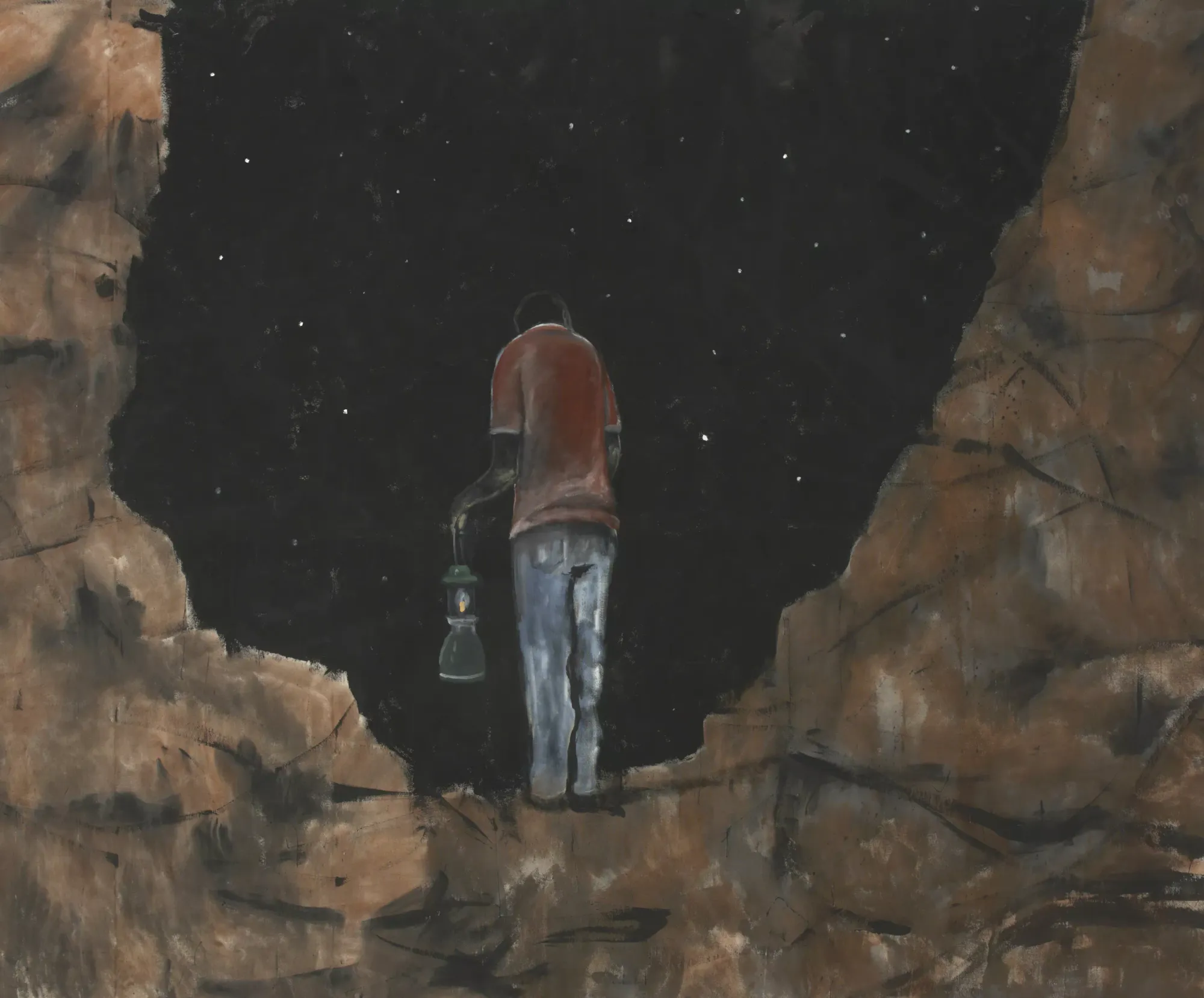
The pièce de résistance in London is Painting for My Dad, an oversized piece more than two meters wide, a dark and looming picture hung on a black wall. Finished shortly after the artist’s father died and a couple years before his own untimely death from cancer, Painting stares into the void with terror and longing and tension and cold acceptance. In his short career, in his short life of 32 years, Noah packed in far more than the exuberance of some fantastic paintings—the rich scaffolding of a social structure for how life might be lived.
Homework Magazine
I was very happy to recently receive in the mail a copy of the first issue of Homework, a new Chinese-language magazine published by Eileen Chien. I met Eileen and learned about Homework through its creative director, Amy Chang, the brilliant graphic designer who I first worked with when I was editing LEAP and invited her to guide our editorial art direction. Since we both moved to Taipei she has become a close friend, so it's great to see her making creative strides while bringing up her family!
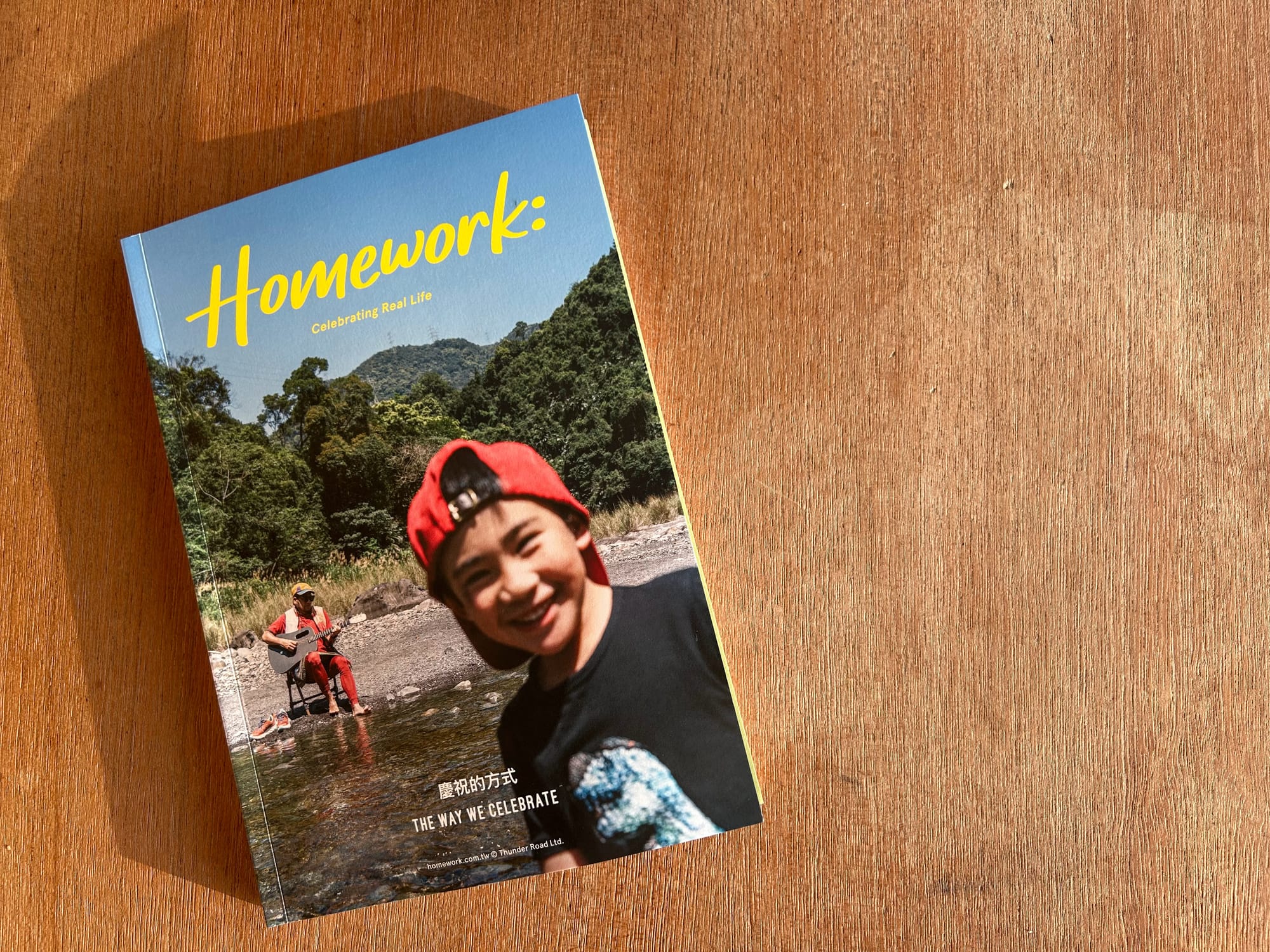
Eileen, too, runs a very creative family (her husband is a music producer who has published on music appreciation for children). The tagline of Homework is “Celebrating Real Life,” and it’s positioned as a lifestyle magazine for people with children, featuring profiles of parents and families of various interests and configurations, as well as Taipei restaurant reviews, recipes, and recommendations for toys, apps, products, books, and music. It’s an approachable sensibility, and a nice addition to the stable of design parenting magazines, which has been lacking ever since Kindling decided to stop publishing after just three issues two years ago. Lately I’ve also been enjoying the offerings from Anorak, which are delightful but a slightly different thing—magazines for children rather than lifestyle magazines for people who happen to have children. Homework positions itself somewhere in the space in between; let’s see how they grow.

Nostos is a weekly newsletter about making a home at the intersection of art and life. Essays is an occasional column that teases out in greater depth how family life appears in culture.
Karl Ove Knausgaard’s profile of Celia Paul, like most of the press she gets, leads with a visit to her flat in London. Based on the descriptions that her interlocutors and interviewers share, it sounds like a theatrically sparse place, a minimally viable configuration of chairs and bed frames that provides just enough surfaces to sit on and gaze into the mid-distance, just enough windows through which to notice a corner of a roof or the branch of a tree, and just enough bare walls against which to lean paintings. Just enough of a space, in other words, for one to focus on the twin projects of looking and being looked at, which she has made the core of her blessedly old-fashioned practice as a painter—a painter of the sort who paints the things in front of her. Knausgaard writes of how he understands her work:
… their distinctive combination of weightlessness and heaviness. The physical, material world that they depicted seemed light in some peculiar way, while their emotional presence was always heavy: the paintings were grounded in feelings. Usually it is the other way around, isn’t it, the material world has weight, and the inner, the spiritual, the abstract are light, and ungraspable, really.
And he might as well be speaking the language of Asle, of the “luminous darkness” that our fictional artist seeks in his paintings. When Jon Fosse (speaking through Asle) writes of how it is only at the darkest moments “when the darkness starts to shine,” this is not only a metaphor for finding the grace of forgiveness and acceptances when the going gets tough; this is very literally how Asle is making his compositions, turning his lights off and looking at them in the gloom of the Arctic dusk, looking for a strength and brightness that he puts onto canvas through overpainting and underpainting. Through the materiality of the painting, Asle incorporates the spiritual sense of the ineffable into landscapes, moments, and portraits. This is what Knausgaard is suggesting here: it’s the light that’s heavy. He comments specifically on Celia Paul’s series of paintings of chairs. She explains herself:
I think my chair paintings are self-portraits. I have two identical chairs: one is in my studio—my models sit on it—and this one, the one that I paint, is in the room where I sleep.
Knausgaard on the same chair paintings:
We see not the chair in itself, as that is for sitting on, but the moment it represents, the here and now it lifts forth. Not the world, but our connection to the world. … Shouldn’t someone have been sitting in that chair? In a strange way, the absence of a person reveals another presence, for, though the room is certainly empty, it vibrates with life, and it does so because someone sees it, and that someone exists in the painting, in its colors and shapes.”
Immediately I think of the twin chairs of Septology, one for Asle and one for his late wife, the presence who haunts his home studio and all corners of his life. She, too, was a painter, though as his career progressed and hers stalled she turned inward and focused on icon painting. We cannot tell if she became a contemporary artist interested in icons or if it was purely a hobby so, although she didn’t seem to exhibit widely, I choose to again hold this contradiction loosely and think of her icons as doing what Asle’s paintings do, reflecting back the light in the darkness.
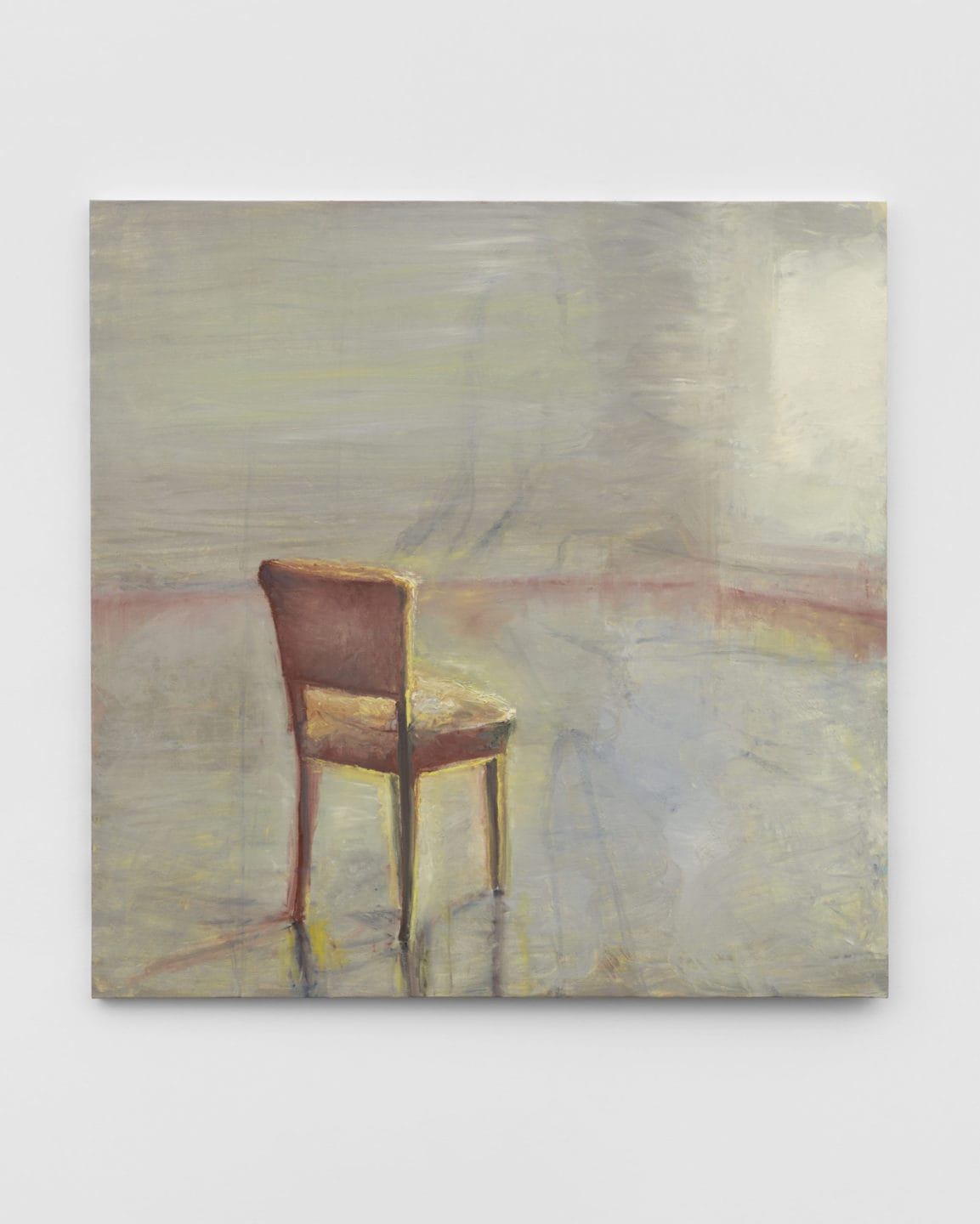
Asle is a rugged individualist of an artist. Though he begrudgingly accepts the companionship of his neighbor and his namesake, his time in the studio is pure solitude. By way of company, he sits and fixes his gaze on a specific portion of the sea. The other chair must remain empty. Celia Paul’s practice, on the other hand, is a profoundly social one. Her work is all about connection. Across the decades, she paints her mother, her sisters, her son, her lover and his friends—all in the same chair, within the same four walls. Her connections to these people matter. That chair glows with the presence of a life lived to the fullest. Knausgaard:
It is easy to think art that leans toward the autobiographical is first and foremost a representation of things or events. But the essential fact about art is that it is an event in itself. It is something that comes into being.
Celia Paul’s Bloomsbury studio, where she has lived since 1982, was a gift from Lucien Freud, her lover, tutor, and portraitist. The space itself, the framework, the walls that surround the chairs, are a part of the practice of living, of loving, of modeling, of painting that she constructed in relationship to him. She has spoken openly of how her work found a new dimension of freedom after he died. Much has been said about their relationship, the degree to which it defines or does not define her work, the extent to which it was positive or healthy or anything else. I’m not sure much of that matters, in that it’s less about that particular relationship and more about the fact of relationship, the field of social connection in which she has chosen to pursue her painting. This is what makes her work so very much of our time. Now in her 60s, Celia has become known for her writing in addition to her painting, and she speaks eloquently on the back-and-forth between these two ways of working:
It is a way of articulating thoughts that otherwise just brew. That can work evocatively in painting. But with words, you need to have order of a different kind. One sentence does have to follow another.
It was her memoir Self-Portrait and the more recent Letters to Gwen John that opened my eyes to the field of connection that underlies her painting practice. Letters, in particular, I find one of the most beautiful meditations there is on how we understand art as a part of life, on how art draws from life and in return gives a sense of shape back to it. In Gwen John, Celia sees a parallel life from another pocket in time—a namesake who lived nearly a century before her.
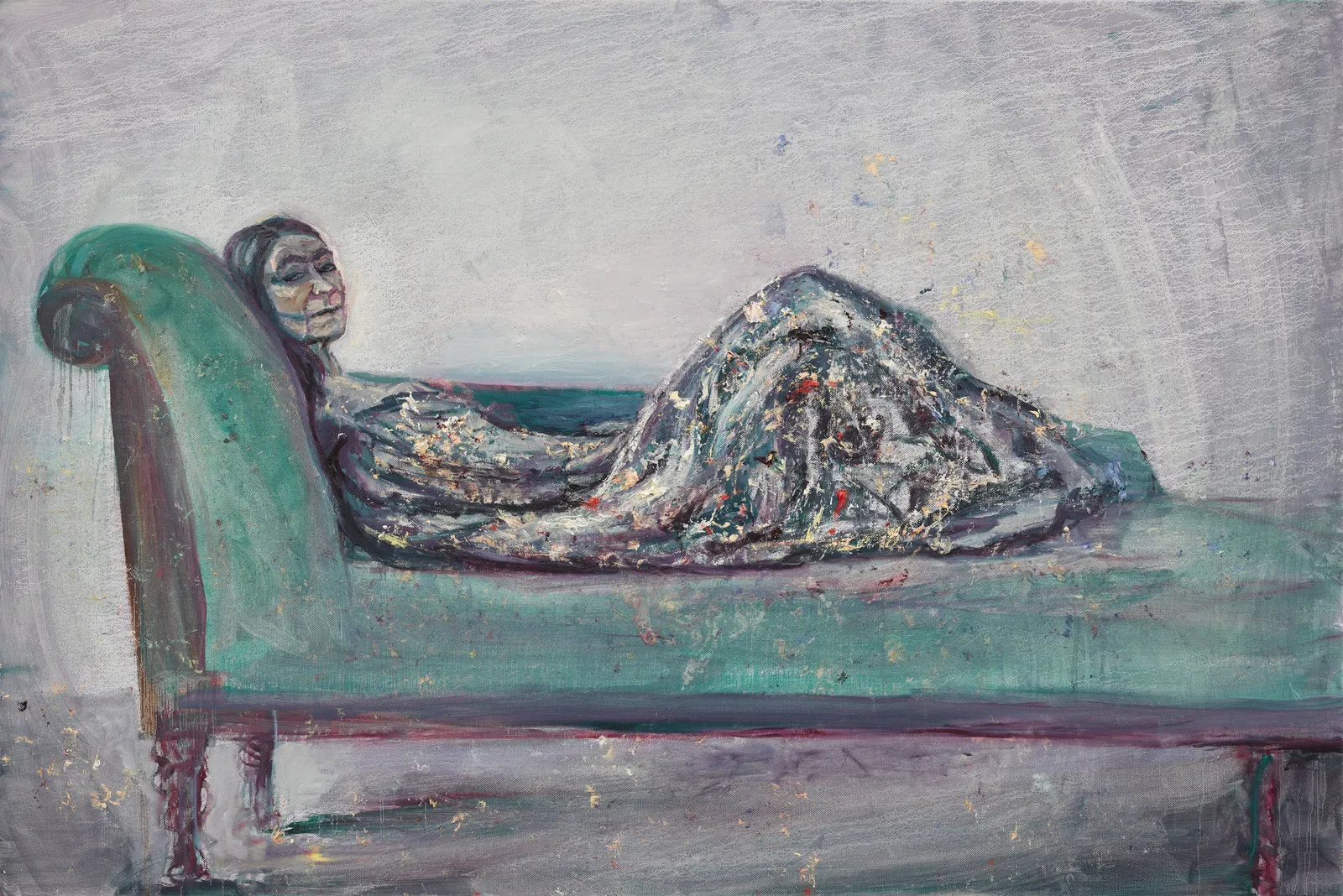
Like Celia, Gwen John studied at the Slade. Like Celia, Gwen John entered into a relationship with an older artist, and their affair became a defining aspect of how she related to art and to the world. In Celia’s letters, we get a sense of how she goes about her day to day, how she thinks about her paintings, but we also get to look at Gwen John’s work, and at Rodin and their milieu, with fresh eyes. Gwen John’s portraits, particularly her self-portraits, printed alongside Celia Paul’s, are revelatory—modern. And yet:
Gwen never tried to paint Rodin and she made no pencil sketches of him. He was her ‘Maitre’ and she was so overwhelmed by him that she wouldn’t have been able to work from him. … She wanted Rodin to look at her, but she didn’t feel able to return his gaze.
In her newest body of work, Celia’s paintings have taken on something of the religious icon for me, as much as they have also absorbed the social portraiture of Freud. In the press release for the new exhibition, “Colony of Ghosts,” her practice is described as “looping back and forth through time to the people and places closest to her. … Constancy and change, and how the past is always held in dialogue with the eternal present of the painted image, are, for Paul, inextricably linked to a consideration of self.” We see in these images a field of space-time that is turned into light, a living and breathing field of life that comes through every object, every surface, every wrinkle on every face, every knuckle on every hand. Reaching into her own past, like Asle:
My young self and I—we are the same person. I can stretch out my old hand—with its age spots—and hold my young unblemished hand.
Nostos is a weekly newsletter about the intersection of art and life. Shorts is a regular column with links and commentary on family culture.
M. Paul Friedberg (New York Times)
Landscape architect M. Paul Friedberg of MPFP passed away last month. His obituary in the New York Times celebrates his contributions to the landscapes of play:
He was inspired by the adventure playgrounds springing up in Europe, where designers had observed children playing in the rubble after World War II. “They realized children really didn’t need formal play environments,” Mr. Friedberg told The New York Times in 1999. “They gave children saws and drills and boxes and called them adventure playgrounds.”
His playscapes are notable for their sheer potential, inviting imaginative uses by children as well as adults. Built in 1965, Riis Park Plaza was a masterpiece, a series of pyramids and stacked volumes for sitting, climbing, running, and jumping that formed an amphitheater, a fountain, a garden, and a playground, each a dedicated space flowing into its neighbors with considered connections. With their inherent sculptural beauty—much like Noguchi’s play equipment—these structures might be better considered landscape design in general rather than playgrounds.
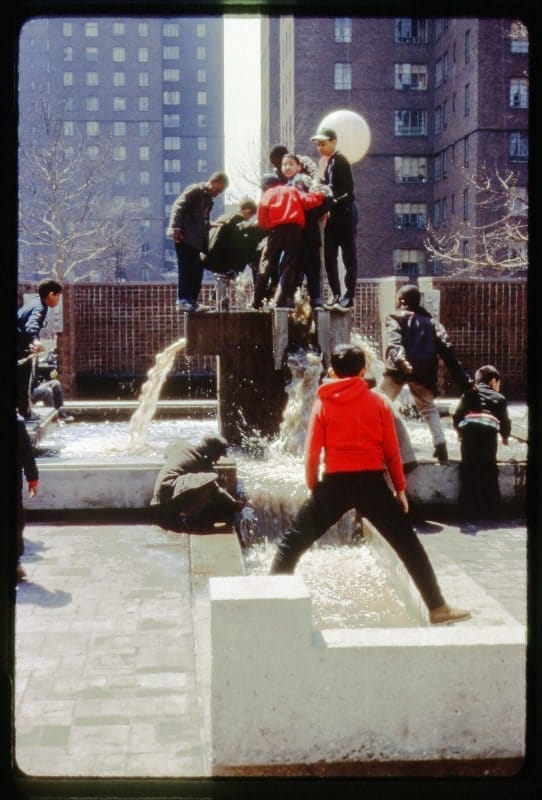
The playable city is a livable city; making environments that are safe, fun, and stimulating for children pays off for everyone. The plaza at the center of the Riis Houses in the East Village has since reverted to fenced-off lawns and standardized play equipment. Friedberg speaks of our tendency to push away out natural inclinations toward creativity and play, and leaves us with this:
There are people whose whole life is dedicated to play, and those are the people we call artists.
Camille Henrot (Hauser & Wirth)
One of my favorite artists, Camille Henrot, has opened her first major New York solo exhibition with Hauser & Wirth this winter. More than a decade ago in Venice, she won the Silver Lion for Grosse Fatigue (2013), a film that gave form to our experience of knowing and feeling after finitude in the internet age; it still rings true, and the conditions it speaks to have only accelerated since.
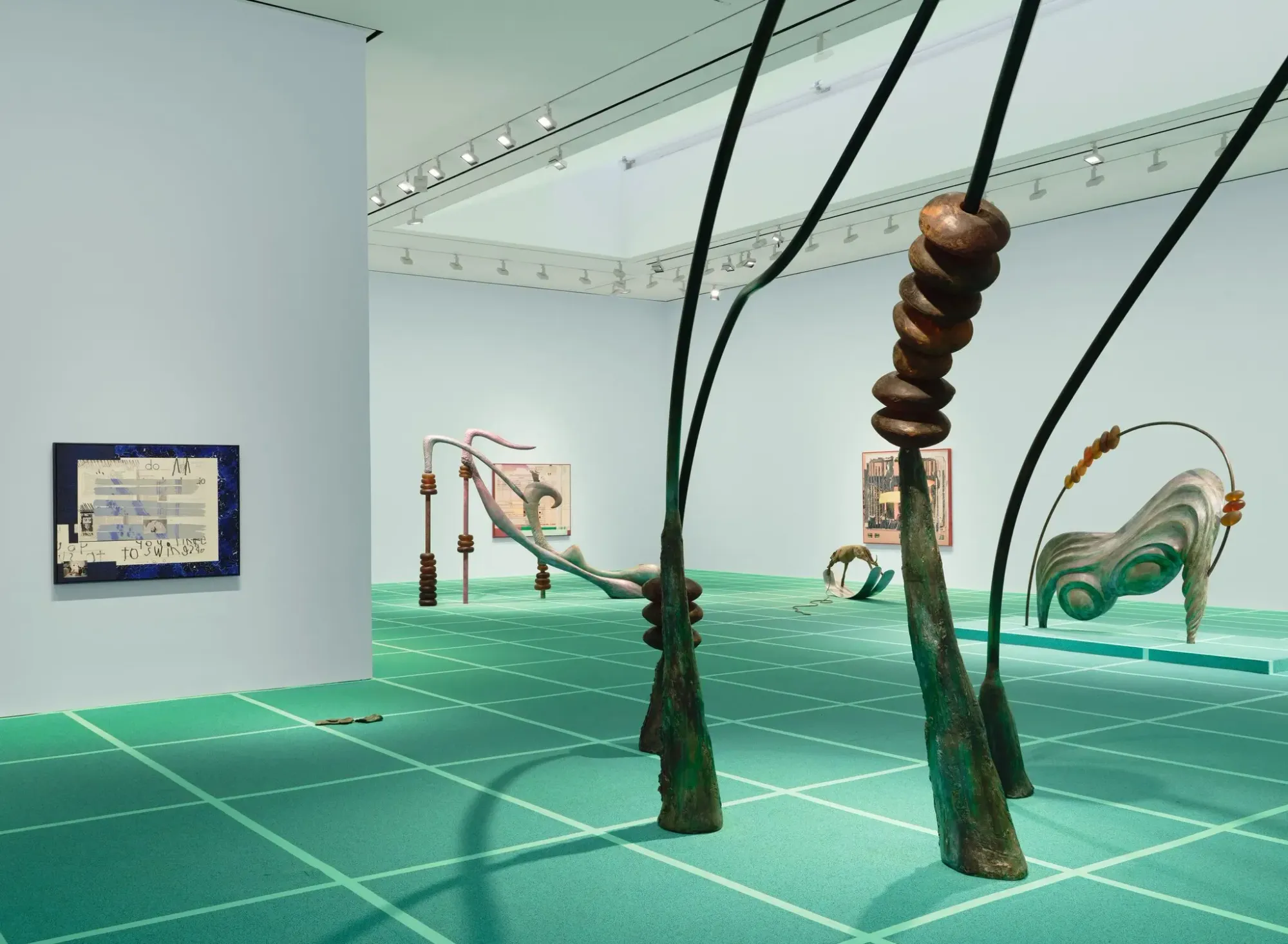
The current New York exhibition, “A Number of Things,” is cool because it allows us to stick with the theme of playground design. Working with the architects Charlap Hyman & Herrero, she has covered the gallery floor with the thick rubber surface that so often undergirds outdoor play structures, a little bit squishy and a little bit bouncy, ready to absorb broken elbows and damaged egos. Here, the playground consists of sculptures in bronze. The most imposing works, from the “Abacus” series, quote the bead mazes of generic waiting rooms in hospitals, offices, and preschools, bringing them to a heroic scale and materiality while also making them a bit sharper, a bit dangerous—more formally interesting. Other works tame the modernist heritage by turning its artifacts into a pack of dogs on leads tied up at the edge of the park. Play is made serious, even critical, while the self-serious is allowed to feel fragile.
In her interview with Artnet, Camille echoes Paul Friedberg almost exactly:
Playing is how we train for life. Not to mention the fact that there is also a huge liberatory power in play. … Between “A Number of Things” worth figuring out is how and when we came about to divorce play from the imagination.
She is also profiled in Frieze and reviewed in the New York Times.
Chris Ware on Richard Scarry (The Yale Review)
Chris Ware is one of our preeminent graphic novelists, and the man responsible for the most epic New Yorker covers. In the Yale Review (which has become a sleeper hit under the editorship of Meghan O’Rourke over the last five years), he has an essay marking the 50th anniversary of Richard Scarry’s Cars and Trucks and Things That Go. Scarry’s graphic dispatches from Busy Town form the texture of childhood for my generation, to the point that there is a well-known meme that is continually making the rounds:
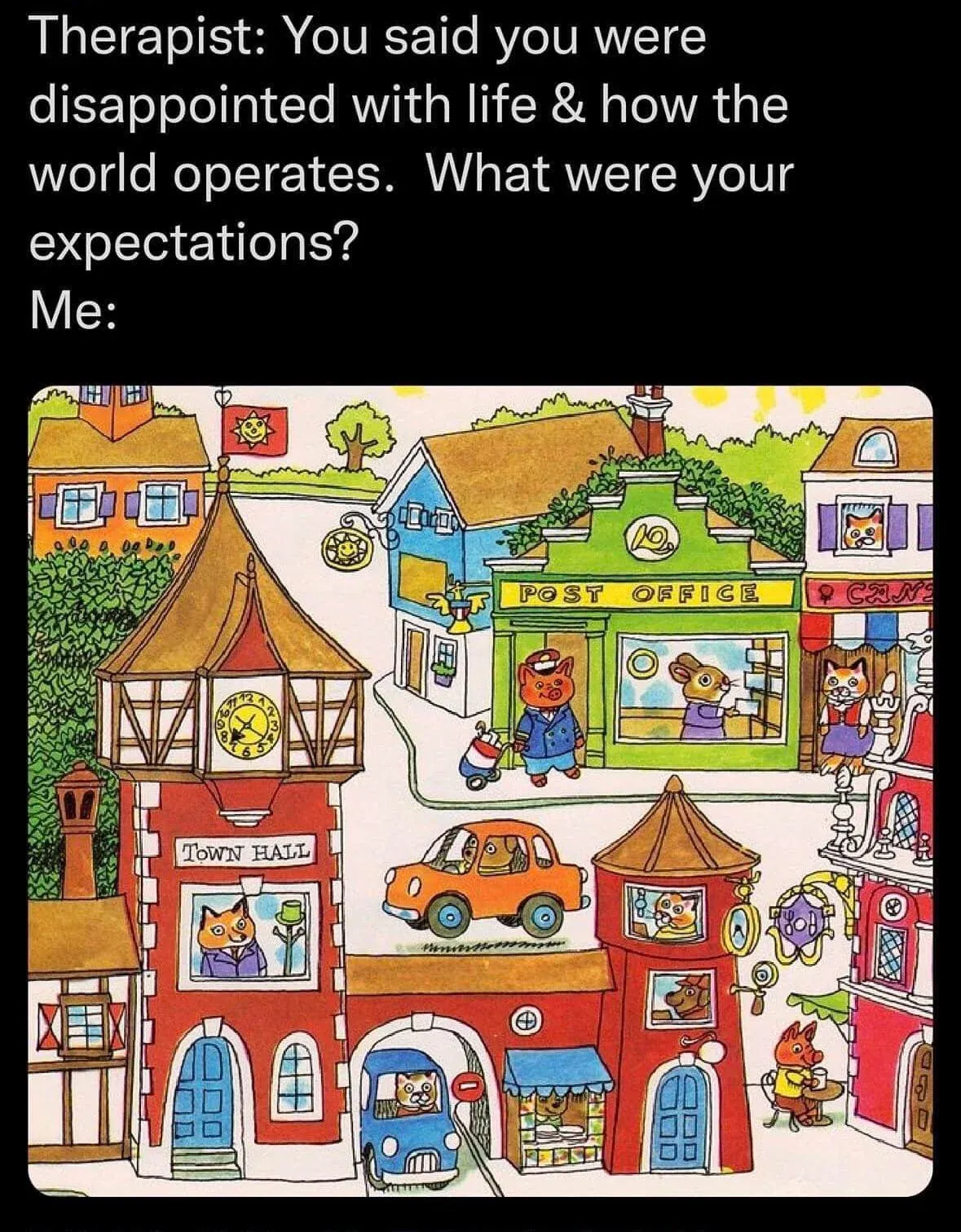
In his essay, Chris sketches out Richard Scarry’s biography, and the happy series of steps that led to the creation of the Busytown expanded universe. Importantly, Scarry spent the Second World War as an art director across Europe and North Africa, later ultimately moving permanently to Lausanne and Gstaad, where he drew the Busytown books:
Scarry’s guides to life both reflected and bolstered kids’ lived experience and in some cases, like my own, even provided the template for it. And while often sweet and quiet in its depiction of a picture-perfect society functioning measuredly—was Busytown urban or suburban or . . . European? (Where did all those Tudor homes and corner groceries come from, anyway?)—there’s just enough innocent mayhem and tripping and falling to hint at a darker side of things, like failing 1970s marriages and the things on television news that adults were always yelling about.
A decidedly un-American tone runs through much of it. By “un-American” I don’t mean anti-American. Instead, I mean there’s a top-down, citizen-as-responsible-contributor, sense-of-oneself-as-part-of-something-bigger that feels, well, civilized.
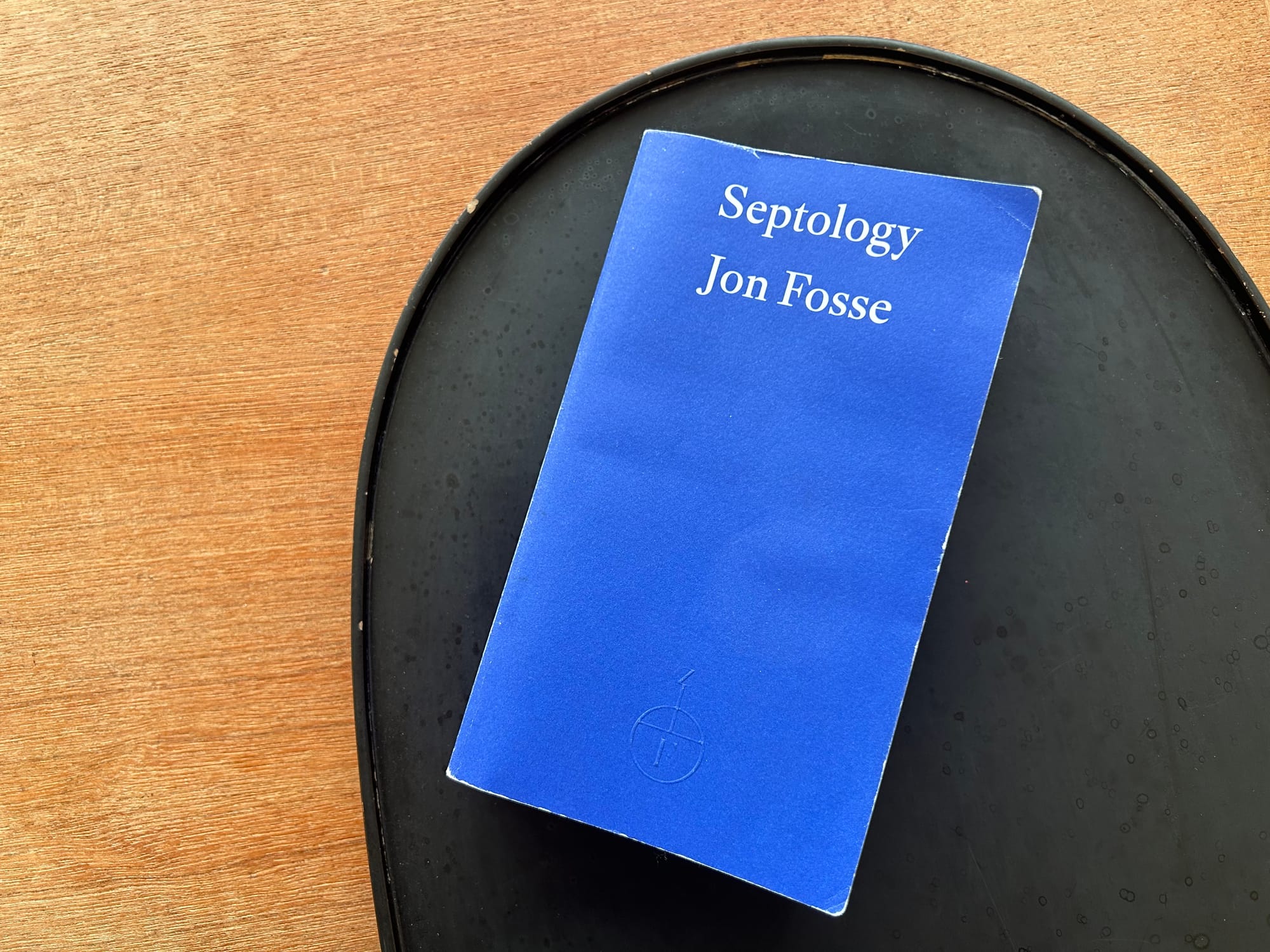
Nostos is a weekly newsletter about the intersection of art and life. Essays is an occasional column that teases out in greater depth how family life appears in culture.
When you finish reading a book like Septology, the impulse is to reach out immediately: to cast about on the internet, to message friends, to wedge it into conversations, to write something down, to figure out what’s sticking in your mind and then compare notes to understand if your experience of the book is coming from inside the book itself or from mythical status of the book.
From what I can tell of my casting about, most people think that Septology is about god. Asle, the aging painter who narrates the novel in his stream of consciousness, falls asleep each night—closing each of the seven volumes of the story—somewhere in the process of moving along his rosary beads, either in the Lord’s Prayer or Salve Regina or Ave Maria or one of those other bits of sacred ritual that have been sadly abandoned in the churches that I grew up in. When he speaks about god, however, he is very clear that he doesn’t believe in god at all, at least not in the traditional “old-man-in-the-sky” conception of god. Asle feels the presence of god in two places: in the love and connection he cultivated with his late wife, and in the creative process of painting that he has spent a lifetime pursuing. To quote William Blake:
Every thing that lives is holy.
Septology contains some of the best descriptions I’ve read of how art functions in the life and mind of the artist. Not all artists, of course, but some of them, and particularly those who remain committed to the modernist idea of art that spans the long twentieth century, bound up with the practice of calling a self into being. With all of the connections between light and the divine that Jon Fosse weaves through his writing on painting, particularly the “luminous darkness,” at a certain point in my reading I started picturing Asle’s work in the key of Celia Paul. Until I started reading her writing, I did not get her work at all. I lacked the capacity to understand not only her work, but probably an entire strand of contemporary art (this same one that I refer to here, the one committed to or at least growing out of the modernist idea of art: individual and spiritual and craftsmanlike, bookended between an earlier institutional aesthetics of ritual, what modernism struggled against, and a later institutional aesthetics of bureaucracy, which art has become). I could not have read Septology without having first read Celia Paul.
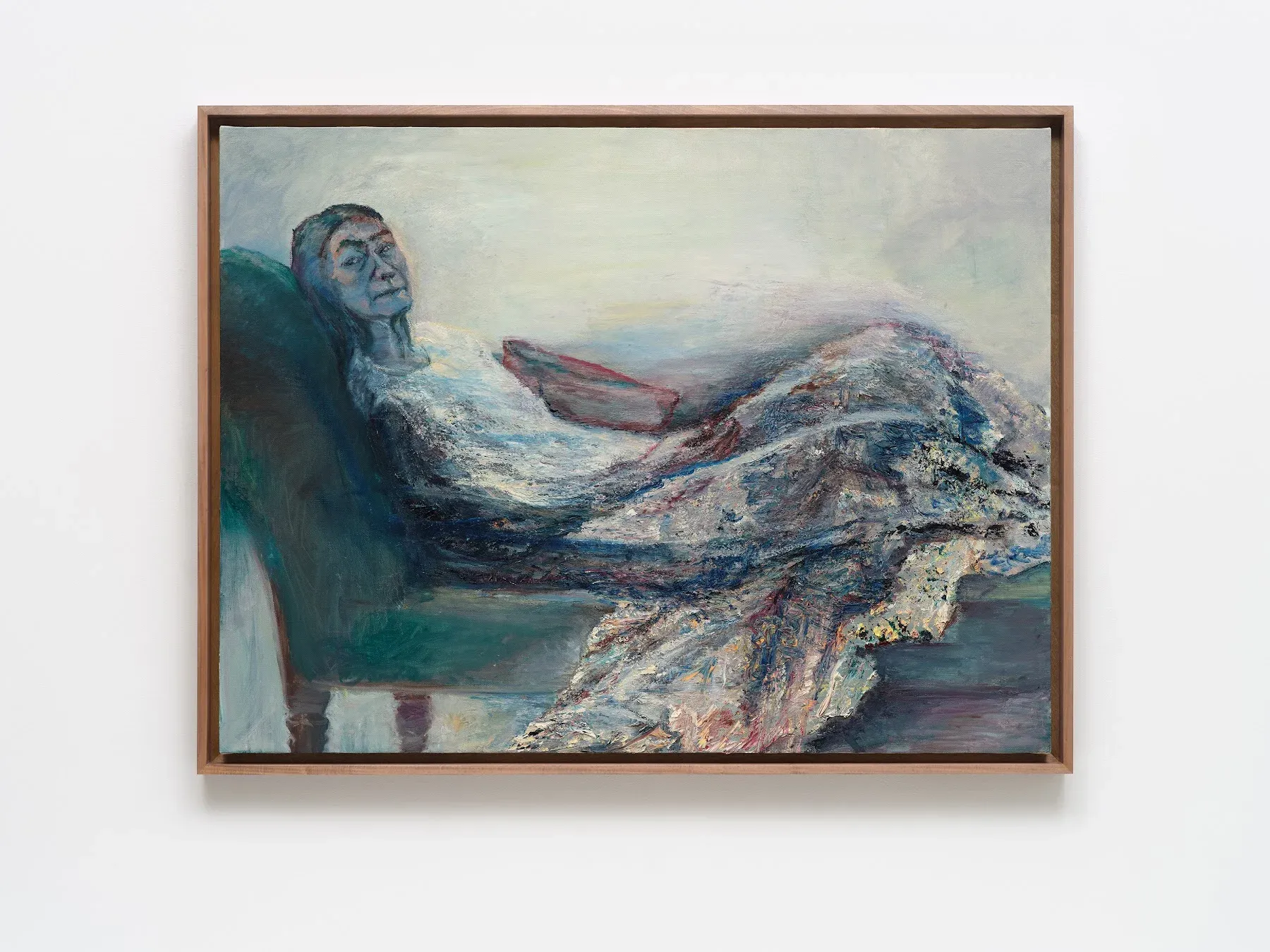
Partway through Septology, I was shocked and gratified to see that Karl Ove Knausgaard, whose blurb sits prominently on the back of my thick Fitzcarraldo edition of the book (“Jon Fosse is a major European writer”), had authored a new essay on Celia Paul, published in the New Yorker and in a MACK monograph to accompany her forthcoming Victoria Miro solo exhibition. Shocked because I did not expect such a literal connection to be manifested into reality, at least not so quickly; gratified because it always feels so predictably good to have my intuitions confirmed or at least paralleled by minds much greater than mine; and then also maybe a little bit mortified, because the timing was all a little bit too perfect, and I wondered if I had perhaps seen a reference to this forthcoming essay and somehow started visualizing Celia’s paintings within Asle’s narrative.
Septology is about the multiverse. Asle seems like a thoroughly wholesome widower, still married in deed and mind to the late love of his life: when his neighbor sits down in her chair, untouched these ten years, his reaction is visceral. As he drives between his home and the city, where he buys groceries and art supplies and delivers paintings once a year to his gallery, he continually encounters phantom versions of himself. He sees himself young and falling in puppy love with his wife; he sees the two of them moving into their first home outside the city (they too, in nested flashback, notice his car driving by). But he also encounters another version of himself, not these shadows of his own past but a present-day alternate reality self, another painter named Asle drinking himself to death. We learn that the two Asles met when they were still teenagers, and have gone through life aware of one another, as the wholesome Asle moves from triumph to triumph in his career and in his marriage, while the shadow Asle suffers through the dissolution of marriages entered too easily, the instability of finances never given a chance to get going, and ultimately the lonely descent into drinking the dark days away.
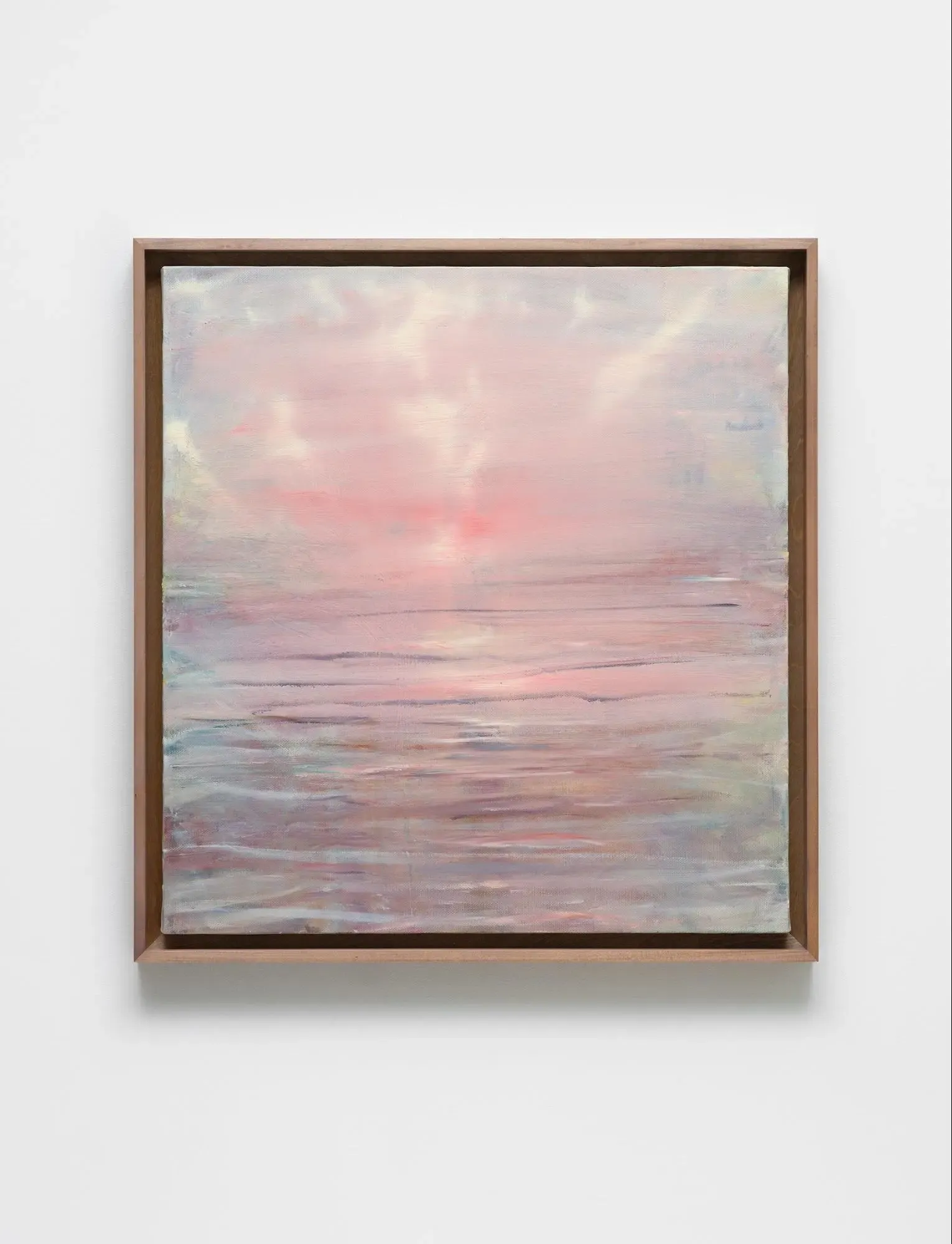
The beauty of first-person narrative, the beauty of this way of telling so many different stories at once, is that we as readers have profound access to the protagonist Asle’s painting. He starts every morning considering the canvas that he is working on, a purple line and a brown line intersecting to form a cross, and we learn about where his paintings come from, how he started painting pastoral scenes from his rural village and then quickly learned to paint out of his mind particular images or moments that stuck with him in his observations of the everyday. He narrates at length the way that light shapes his process: “the pictures I paint in spring and summer have to wait until autumn or winter before I can really see them, yes, in the darkness, yes, I need to see pictures in the dark to see if they shine, and to make them shine more, or better, or truer, or however it’s possible to say it, anyway the picture has to have the shining darkness in it.” Then, when he paints a portrait, which he does rarely—one portrait of his wife sits leaning against a chair in his attic; he also paints his neighbor’s sister sight unseen as a Christmas present—we see Celia Paul. I am incapable of imagining these pictures as anything else. They sit so clearly in my mind that I fear their dark luminosity will be burned into my eyelids.
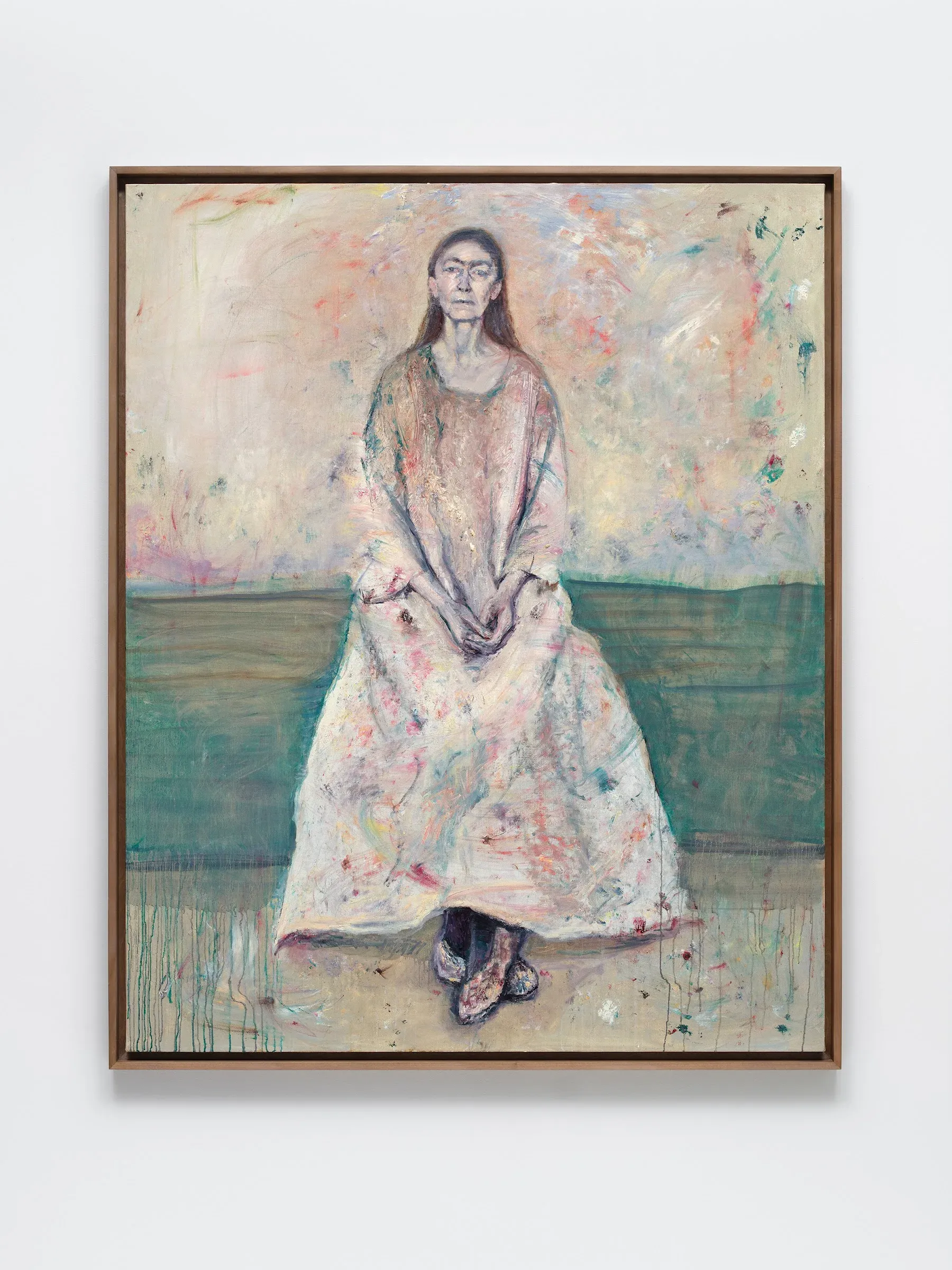
And yet, a bit weirdly, we have no conception of what the other Asle’s paintings might look like. We read about his work only during the time when light Asle and dark Asle first meet: dark Asle is living in a basement and sleeping with a pub waitress, and they are introduced by a mutual drinking buddy. They bond over a mutual resistance to painting the kinds of anodyne pastoral scenes that people from their villages are willing to buy. This is all we learn of dark Asle’s work; it is like he represents an arrested development in the process of artistic growth. Light Asle has already started moving on, but dark Asle feels bound by circumstance to keep churning them out: he sells his pictures for beer money on the steps of the pub. And yet, it is dark Asle who is first accepted to art school, and dark Asle who implicitly gives light Asle permission to leave high school early to pursue this track. We never see dark Asle’s work again.
A lot of doubling and doppelganging is happening in culture right now. In both Severance and The Substance, the public self and the private self struggle over agency. We share one body and, perhaps, one soul, but choice and chance conspire to create circumstances that splinter our realities. The work of love is the work of reconciliation. You are one. God is in the darkness:
It’s in the hopelessness and despair, in the darkness, that God is closest to us, but how it happens, how the light I get clearly into the picture gets there, that I don’t know, and how it comes to be at all, that I don’t understand … it’s definitely true that it’s just when things are darkest, blackest, that you see the light, that’s when this light can be seen, when the darkness is shining, yes, and it has always been like that in my life at least, when it’s darkest is when the light appears, when the darkness starts to shine, and maybe it’s the same way in the pictures I paint, anyway I hope it is
Septology is not a morality tale. Hero Asle and shadow Asle are not two choices that a person can make—righteous choices do not lead to mystically good ends, and dissolute choices do not drag one down into despair. The two Asles are one and the same, fundamentally and inextricably bound together. How this works within the universe of the book, I have no idea. I choose to read it at a distance, to allow these paths and routes to wrap around one another and intersect as they choose. As a reader, I hold this contradiction loosely, like the composition of the painting that opens each chapter:
two lines that cross in the middle, one brown and one purple, and I see that I’ve painted the lines slowly, with a lot of thick oil paint, and the paint has run, and where the brown and purple lines cross the colours have blended beautifully and I think that I can’t look at this picture any more